Choosing the proper plants is crucial for building a thriving garden. Choosing the types that will thrive in your region’s hardiness zone, which the USDA establishes depending on typical annual minimum conditions.
You should also select plants that thrive in the type of sunlight in your garden.
Gardens with a southwestern aspect receive full sun and receive the majority of the strong afternoon sun.
Plants that grow in this style of the landscape should be capable of withstanding high temperatures and flourishing in direct sunlight.
30 Plants for Southwest Facing Garden
- Bunny Ears Cactus
- Spanish Bayonet
- Desert Sunflower
- Green-Flowered Hedgehog Cactus
- Autumn Sage
- Texas Red Yucca
- Red Hyssop
- Tetraneuris
- California Fuchsia
- Perennial Sunflower
- California Poppy
- Pineleaf Penstemon
- Wine Cups
- Yellow Columbine
- Indian Paintbrush
- Dill
- Sedums
- Lisianthus
- Gold Mound Spirea
- Basil
- Begonias
- Rosemary
- Dwarf Fothergilla (Fothergilla Mount Airy)
- Chives
- Pentas
- Rock Cotoneaster (Cotoneaster Horizontalis)
- Tatarian Dogwood (Cornas Alba)
- Thyme
- Sweet Alyssum
- Flamingo Willow (Salix Integra Flamingo)
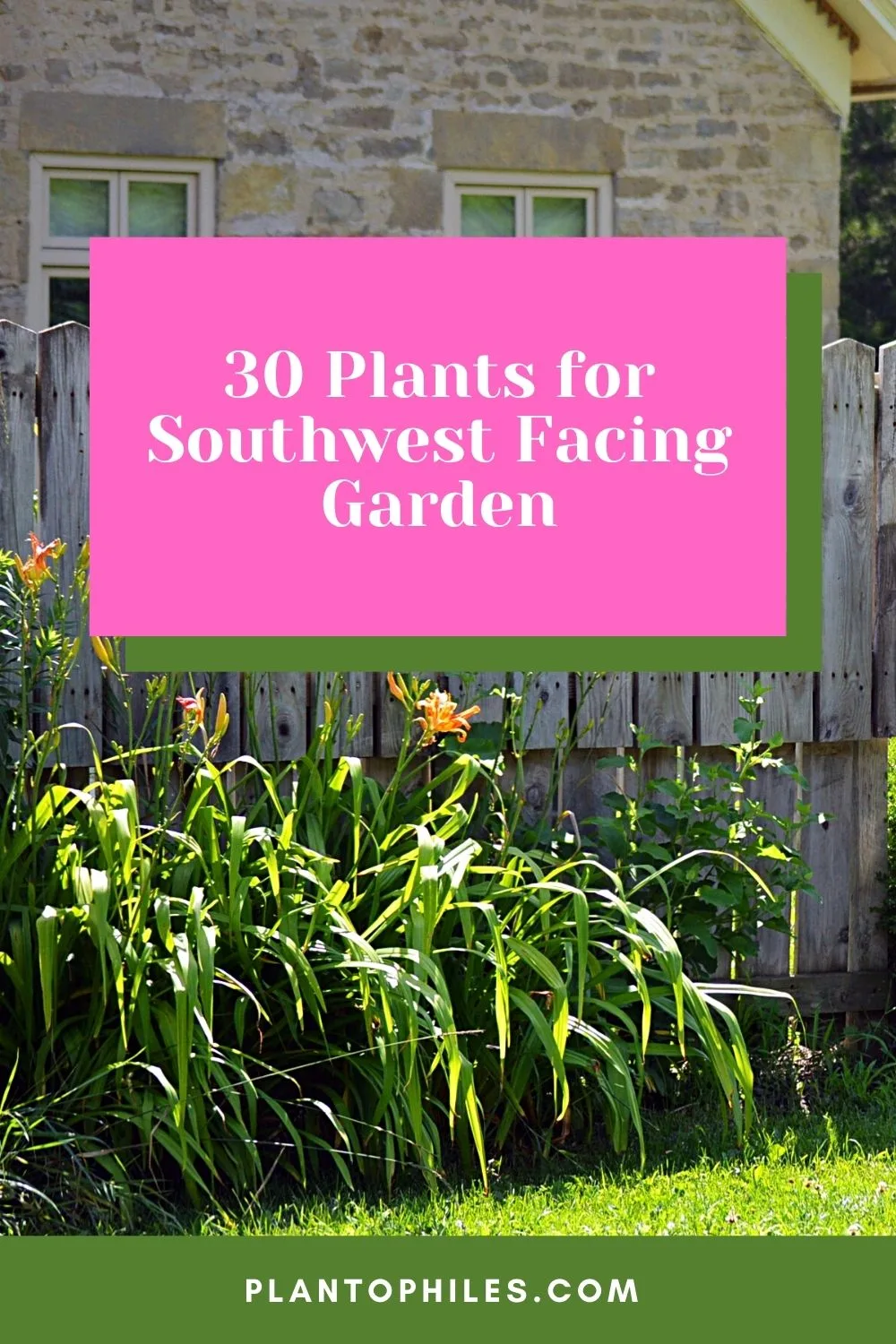
30 Plants for Southwest Facing Garden
30 Plants for Southwest Facing Garden
1. Bunny Ears Cactus
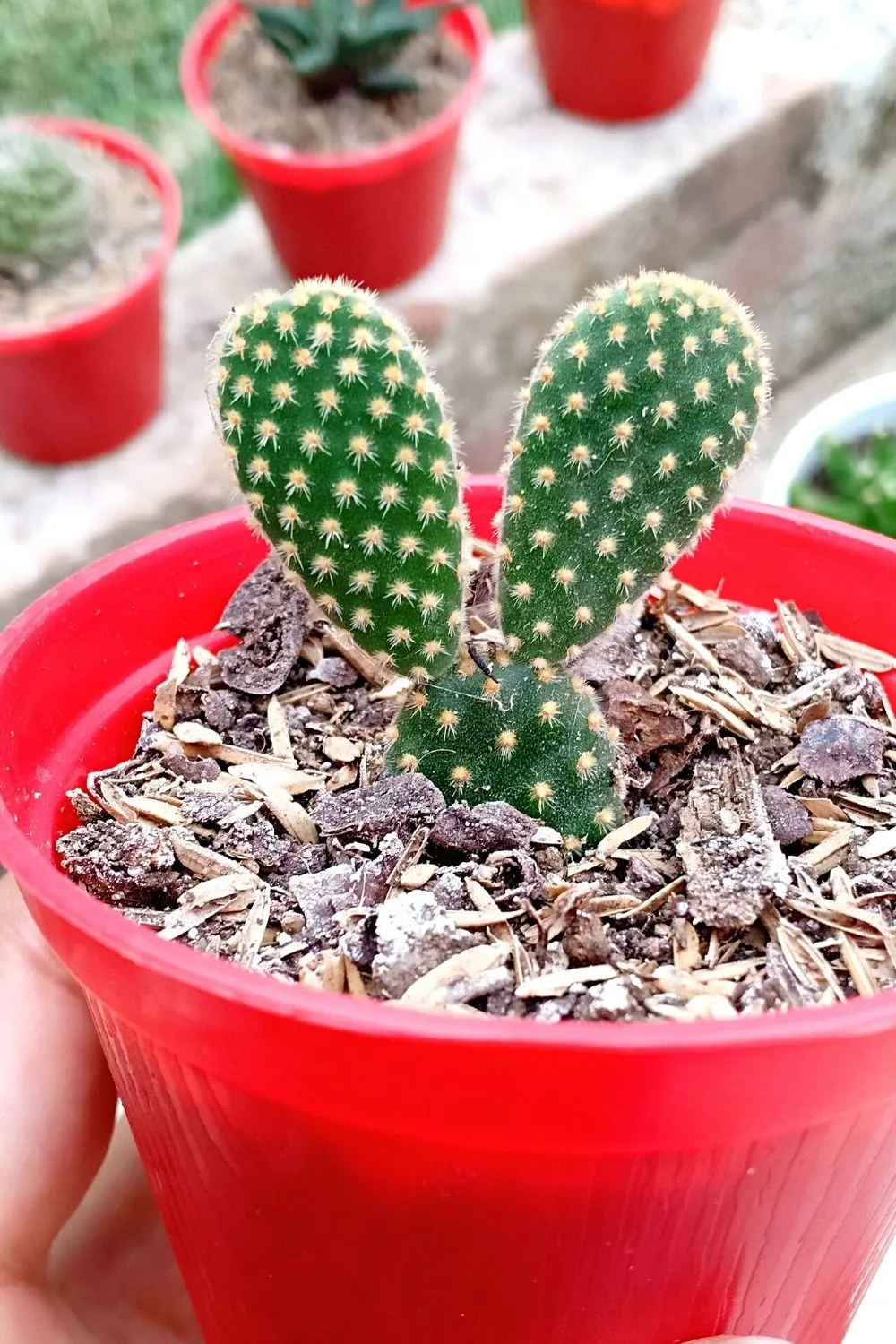
If you’re looking for a cheap yet attractive plant to grow by your southwest facing garden, Bunny Ears Cactus is your best bet
The Bunny Ear Cactus is a popular houseplant that grows well in warmer It naturally grows in Mexico. It is a cactus; therefore the use of gloves and other safety measures are required.
The botanical name according to the University of Arizona is Opuntia microdasys.
It is a small growing cactus that branches and grows dense clumps. The Bunny Ear Cacuts gets up to 3 feet tall.
Bunny Ears Cactus is easy to handle and thrives even if neglected.
Providing adequate sunlight and avoiding overwatering are crucial aspects of having the bunny ear cactus healthy and growing.
- Name: Opuntia Microdasys
- Size: 2 to 3 feet (24-36 inches) tall
- Zones: Hardy in zones 9 to 11
- Fertilizer: Needs fertilizer for succulents early in spring
- Growth rate: Slow grower
- Temperature: 70-100 degrees Fahrenheit (21-36 degrees Celsius)
- Lighting: Full sun exposure
- Humidity: 10 to 30 percent
- Soil: Well-draining sandy
- pH: 5 to 7
2. Spanish Bayonet
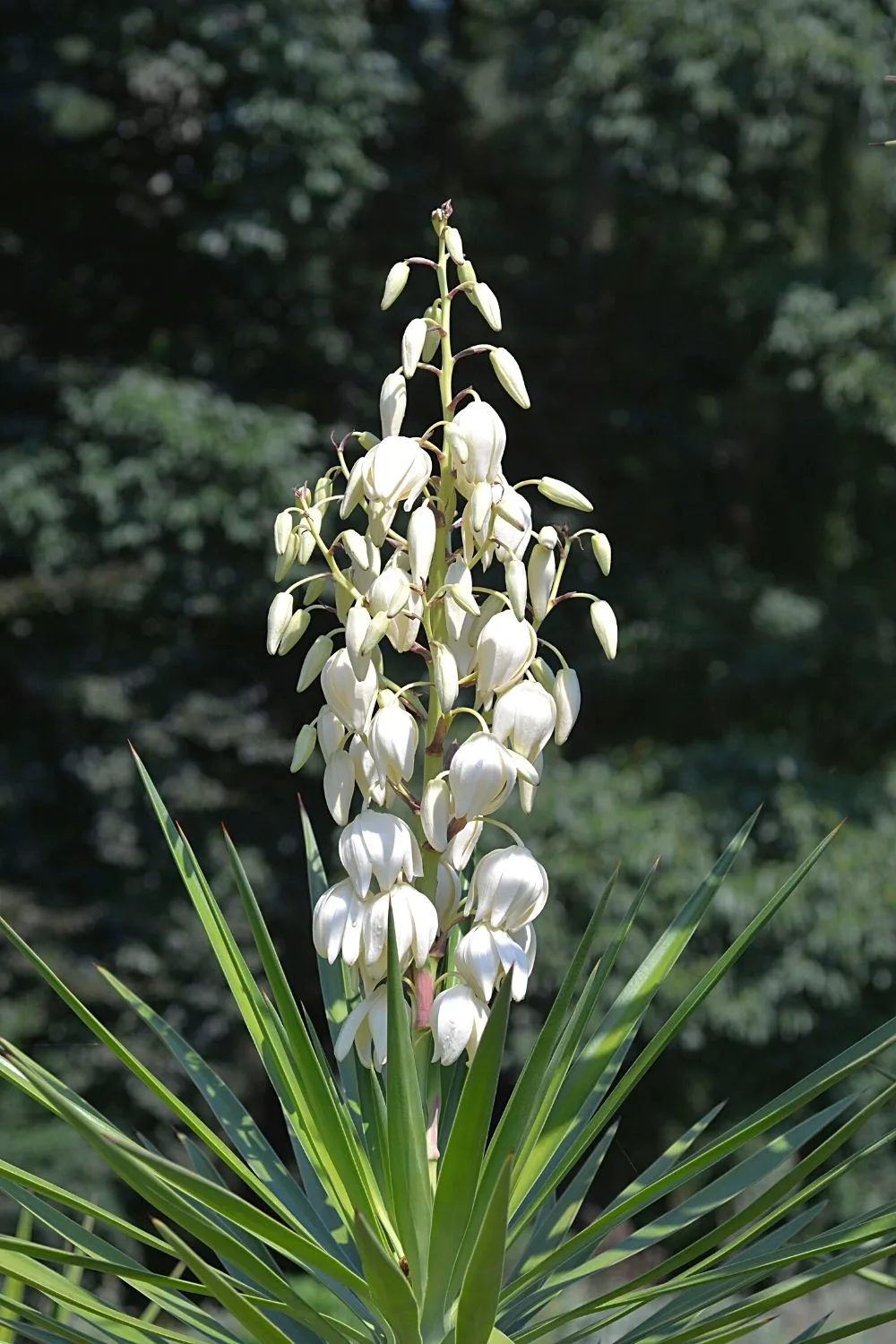
Spanish Bayonet is known for its bell-shaped, drop down, and six-parted blooms, hence, a great addition to your southwest facing garden collection
The Spanish bayonet is an annual branching plant with huge spikelets of showy white blooms that blossom in enormous terminating inflorescences. Single flowers are bell-shaped, drop down, and six-parted.
They are often purple-tinged, are rigid, and have pointed tips.
- Name: Yucca Aloifolia
- Size: 10 to 15 feet (12-180 inches) tall
- Zones: Hardy in zones 7 to 11
- Fertilizer: Organic fertilizer only if you want the plant to grow faster
- Growth rate: Slow to moderate
- Temperature: 50-60 degrees Fahrenheit (10-14 degrees Celsius)
- Lighting: Full sun
- Humidity: High humidity
- Soil: Well-draining cactus soil or potting soil with pumice
- pH: 8 to 10
3. Desert Sunflower
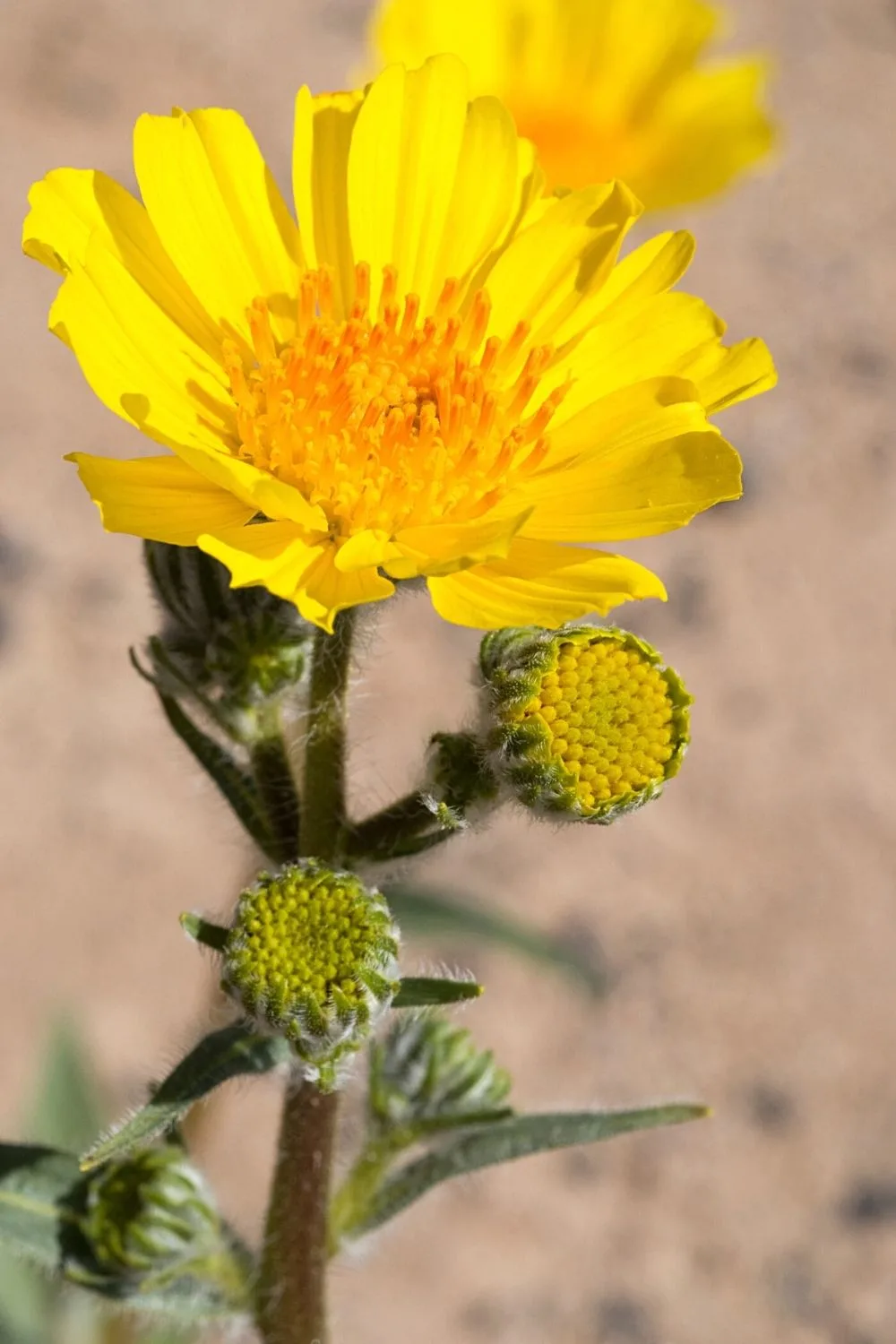
Desert Sunflower, known for its yellow, daisy-like blooms, adds a pop of color to your southwest facing garden
Desert sunflower is a blooming favorite with yellow, daisy-shaped flowers that emerge all through the springtime, and it may rebloom in the autumn.
When the flowers aren’t blooming, the fuzzy grey foliage, which is resilient to rabbits and deer, takes center stage.
- Name: Geraea canescens
- Size: 3 feet (36 inches)
- Zones: Annual
- Growth rate: Fast growers
- Temperature: 70 to 78 degrees Fahrenheit (21-25 degrees Celsius)
- Lighting: Requires full sun
- Soil: Gravelly or dry sandy soil
- pH: 4 to 7.8
4. Green-Flowered Hedgehog Cactus
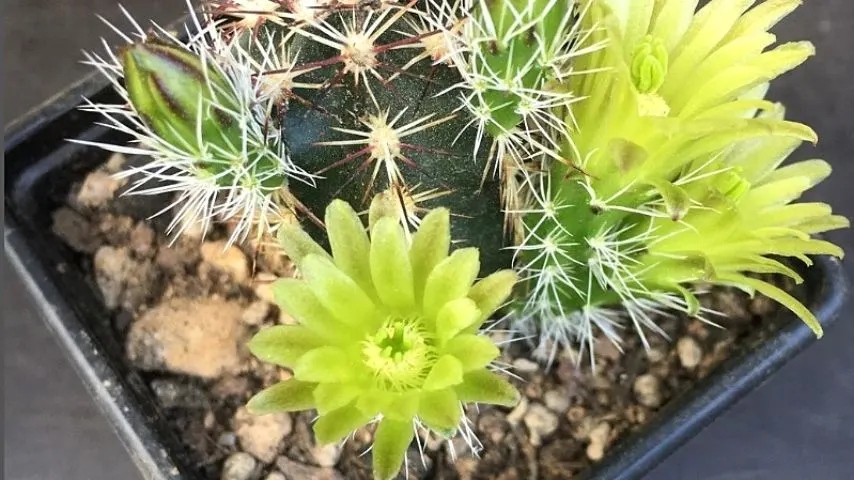
Photo Credit: @auxjardinsdelaroumiguiere on Instagram!
Echinocereus viridiflorus differs from many other hedgehog varieties because it is frost-hardy and has tiny blossoms that emerge down the stalk instead of near the apex.
- Name: Echinocereus viridiflorus
- Size: 75 feet (9 inches) tall
- Zones: Hardy in zones 4 to 10
- Fertilizer: Regular dose of diluted cactus fertilizer
- Growth rate: Slow grower
- Lighting: Partial shade to full sun
- pH: 6 to 7.5 (neutral)
5. Autumn Sage
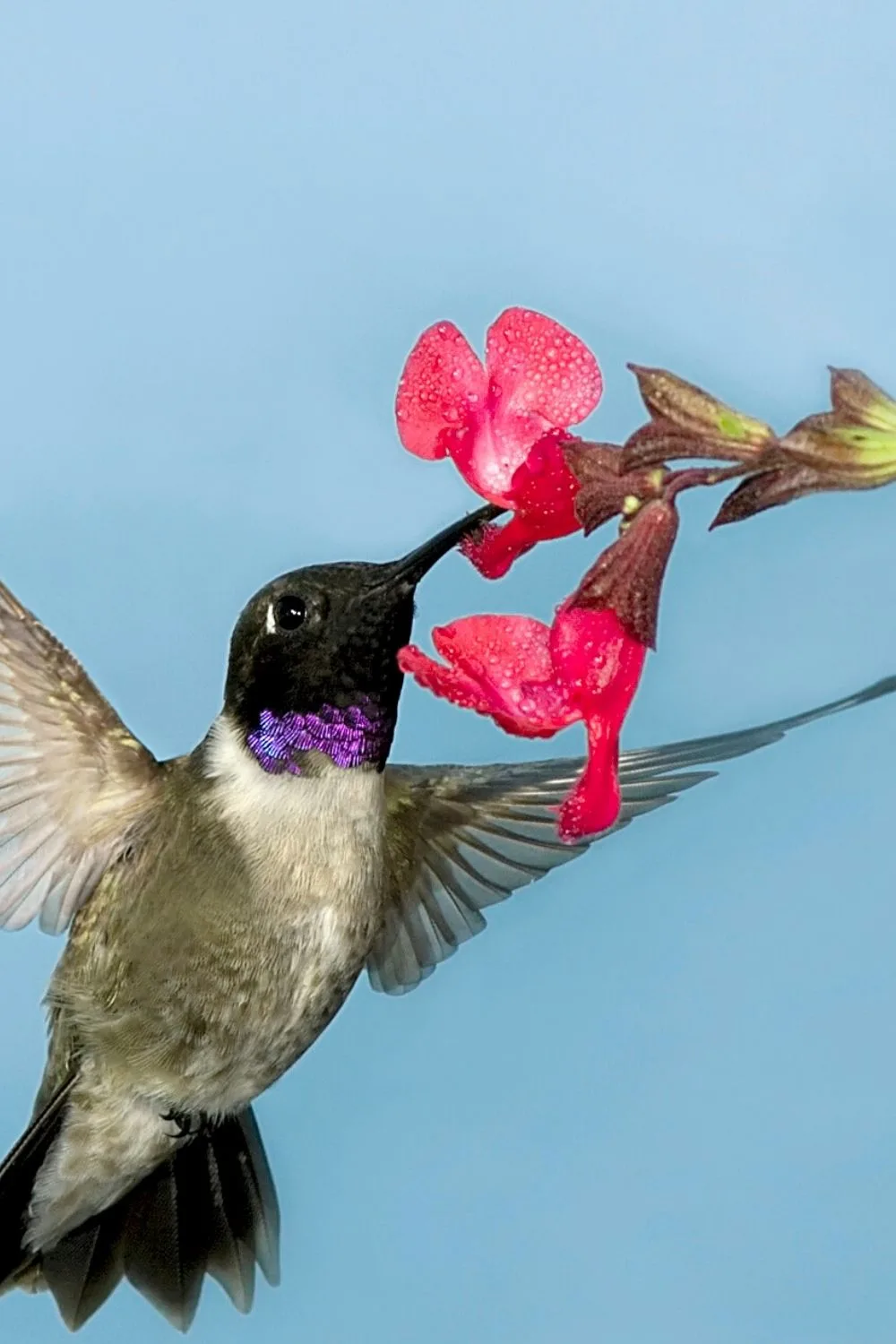
Autumn Sage is another attractive plant you can grow on your southwest facing garden
Salvias are among the plants that are hard to match almost anywhere.
Autumn sage is a very attractive plant with everlasting leaves and bunches of red, violet, pinkish, or purple blossoms that emerge from midsummer to fall.
Butterflies and hummingbirds love feeding on this salvia, just like the other varieties of this species.
- Name: Salvia greggii
- Size: 2 feet (24 inches) tall
- Zones: Hardy in zones 7 to 10
- Fertilizer: Slow-release fertilizer pellets
- Growth rate: Fast grower
- Temperature: 15 degrees Fahrenheit (-9 degrees Celsius)
- Lighting: Do best in full sun
- Humidity: Prefers low humidity level
- Soil: Fertile that drains well
- pH: 1 to 7.8
6. Texas Red Yucca
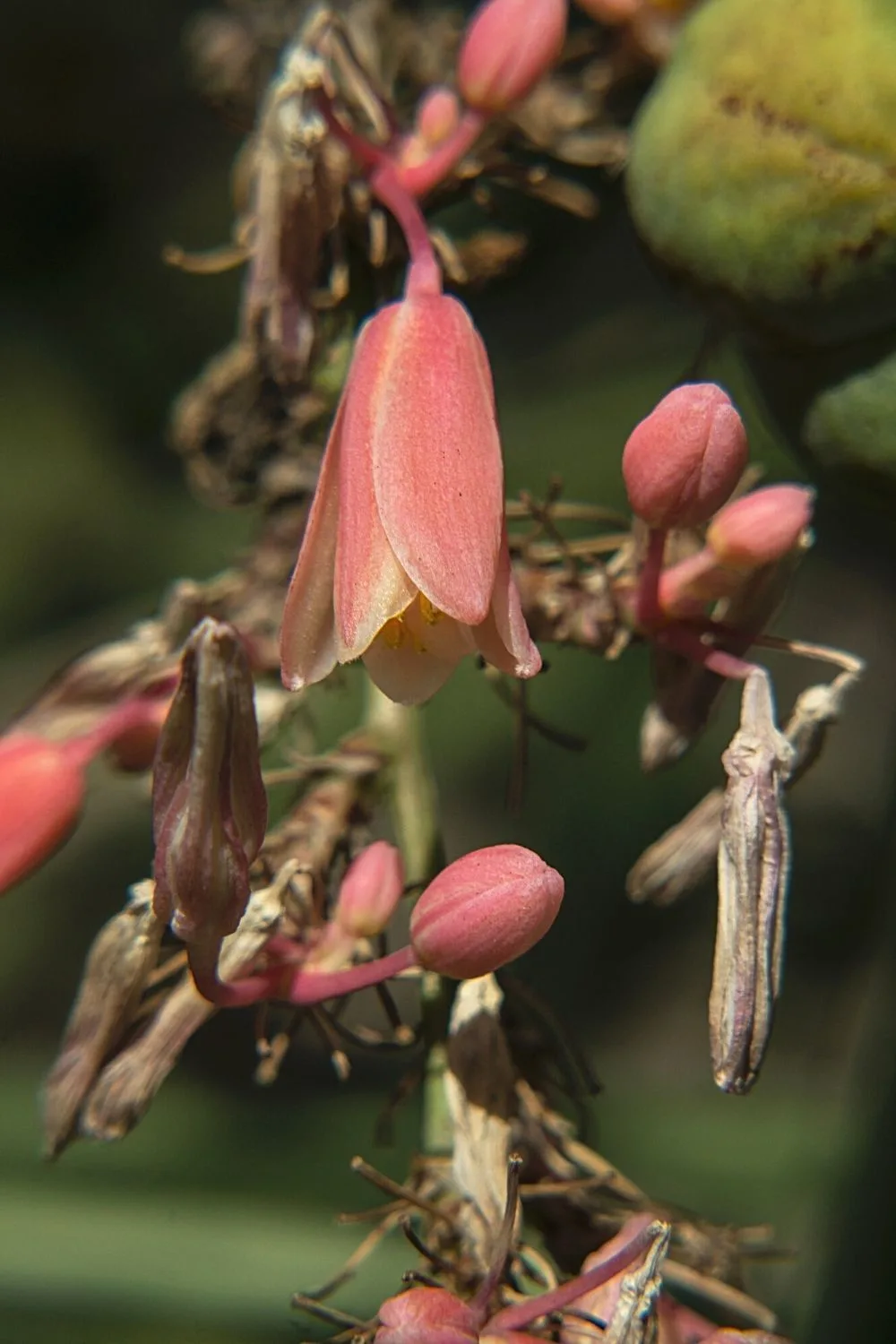
Another attractive plant that grows vivid red blooms on your southwest facing garden is the Texas Red Yucca
Texas Red Yucca, a species that can be easily included in your garden, blooms vivid red in the summertime and draws a swarm of the hummingbird.
The plant can withstand direct sunlight and requires little water to thrive, a quality found in Southwestern indigenous.
- Name: Hesperaloe parviflora
- Size: 4 feet (48 inches) tall
- Zones: Hardy in zones 8 to 10
- Fertilizer: Requires feeding with a general-purpose fertilizer in springtime
- Growth rate: Slow grower takes around 4-5 to fully mature
- Temperature: 60-69 degrees Fahrenheit (15-20 degrees Celsius)
- Lighting: Full sun exposure
- Humidity: Less than 30 percent
- Soil: Sandy soil that drains well
- pH: 8 to 7.2
7. Red Hyssop
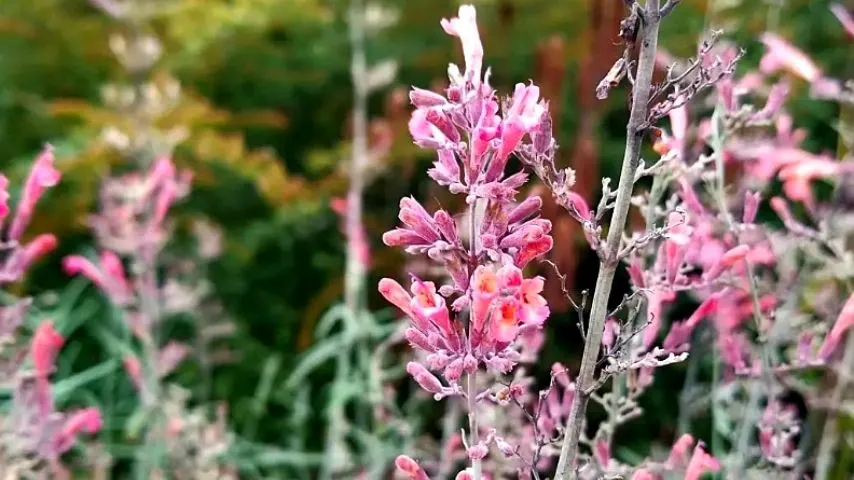
Photo Credit: @gardening_kristi on Instagram!
Agastaches are suitable for almost any climate, and the variety of red hyssop is a particularly nice selection.
This hardy, drought-resistant annual has long-lasting orange, crimson, or apricot blooms in the summers. The fragrant leaves ensure that animals avoid it.
- Name: Agastache rupestris
- Size: Up to 4 feet (48 inches) tall
- Zones: Hardy in zones 4 to 9
- Growth rate: Moderate
- Lighting: Requires full sun
- Soil: Well-draining, compost-rich, and sandy soil
- pH: 6 to 7
8. Tetraneuris
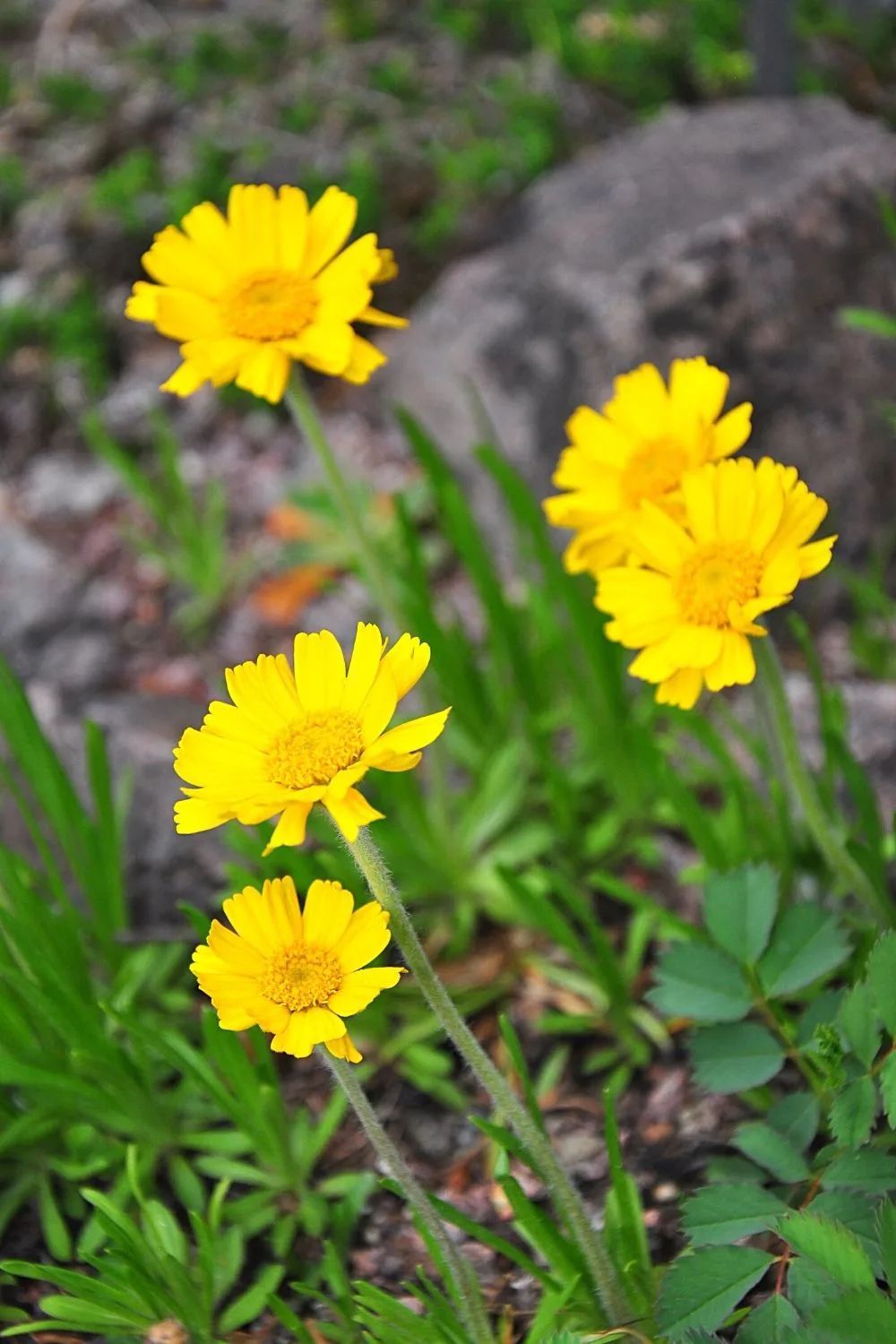
If you’re looking for a long-blooming plant, Tetraneuris is the best choice for your southwest facing garden
Tetranueris is a miniature plant with orderly masses of blue-green leaves and stunning daisy-shaped yellowish blooms.
The plant flowers for a very long time, starting from spring and blooming till autumn.
- Name: Tetraneuris acaulis
- Size: 5 feet (6 inches) tall
- Zones: Hardy in zones 4 to 8
- Fertilizer: Half-strength liquid fertilizer
- Growth rate: Moderate grower
- Temperature: Can tolerate as low as negative 20 degrees Fahrenheit (-29 degrees Celsius)
- Lighting: Full sun to partial shade
- Soil: Clayey soil with good drainage
- pH: Neutral, alkaline, acidic
9. California Fuchsia
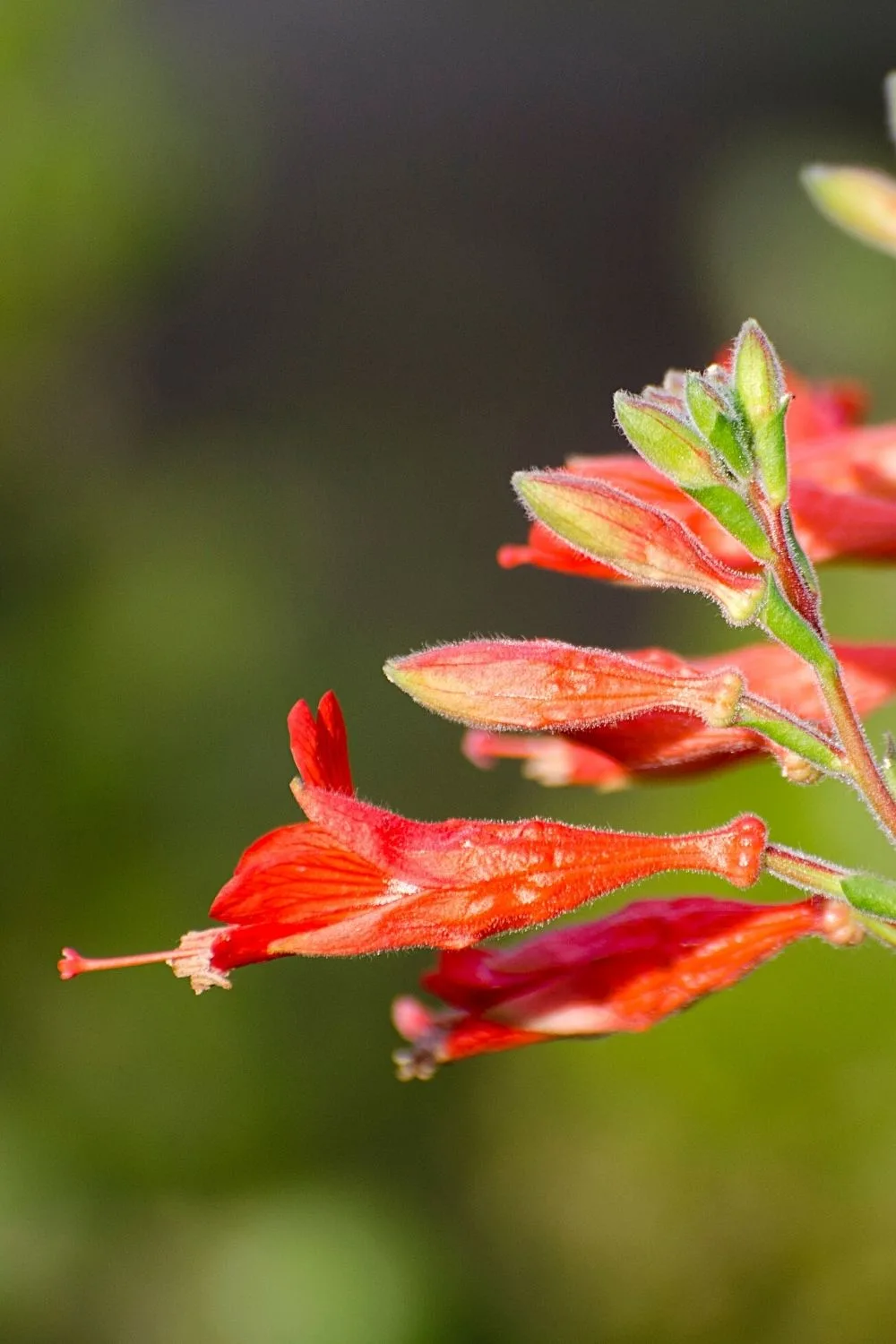
Like the Autumn Sage, California Fuchsia also attracts butterflies and hummingbirds when planted in your southwest facing garden
This lovely perennial plant grows magnificent orange and crimson blooms in summer.
Hummingbirds and butterflies adore the flowers of this plant because they last for a long time.
- Name: Zauschneria californica
- Size: 1 foot (12 inches) tall
- Zones: Hardy in zones 8 to 10
- Fertilizer: All-purpose soil fertilizer
- Growth rate: Fast grower
- Temperature: Cold hardy to minus 24 degrees Fahrenheit (-30 degrees Celsius)
- Lighting: Bright morning sunlight
- Humidity: Low humidity levels
- Soil: Sandy or loamy, well-draining
- pH: 6 to 8
10. Perennial Sunflower
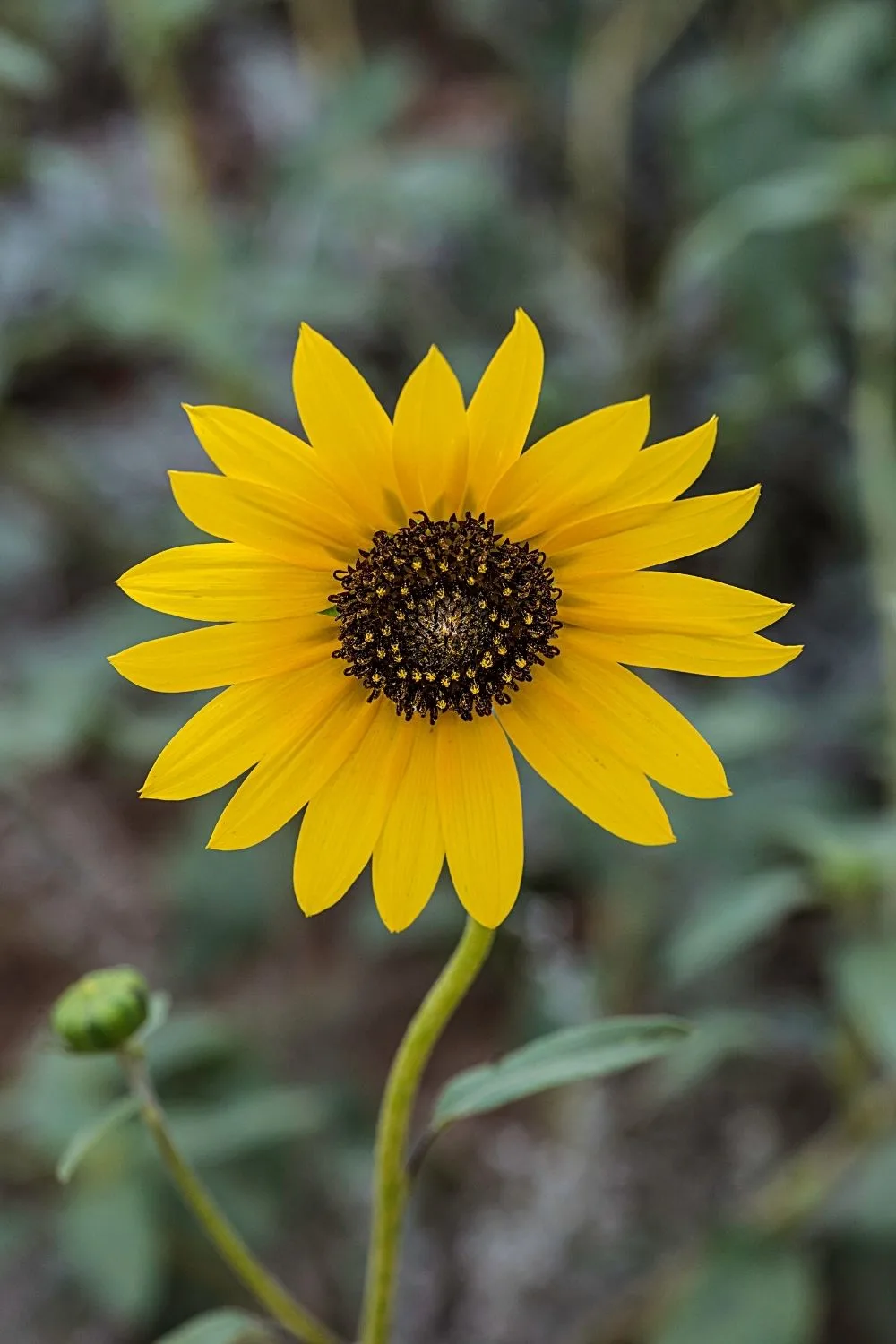
Another colorful plant to grow in your southwest facing garden is the Perennial Sunflower
The perennial sunflower is among the most colorful plants in the fall. Hundreds of vivid yellow blossoms adorn long branches, attracting a huge number of butterflies.
The pastel variety ‘Lemon Queen’ is among the most liked ones.
- Name: Helianthus maximiliani
- Size: Up to 8 feet (96 inches) tall
- Zones: Hardy in zones 4 to 9
- Fertilizer: Use fertilizer rich in nitrogen
- Growth rate: Moderate
- Temperature: 60-70 degrees Fahrenheit (15-21 degrees Celsius)
- Lighting: 6 hours of full sun
- Soil: Fertile and rich soil
- pH: 6 to 7.5
11. California Poppy
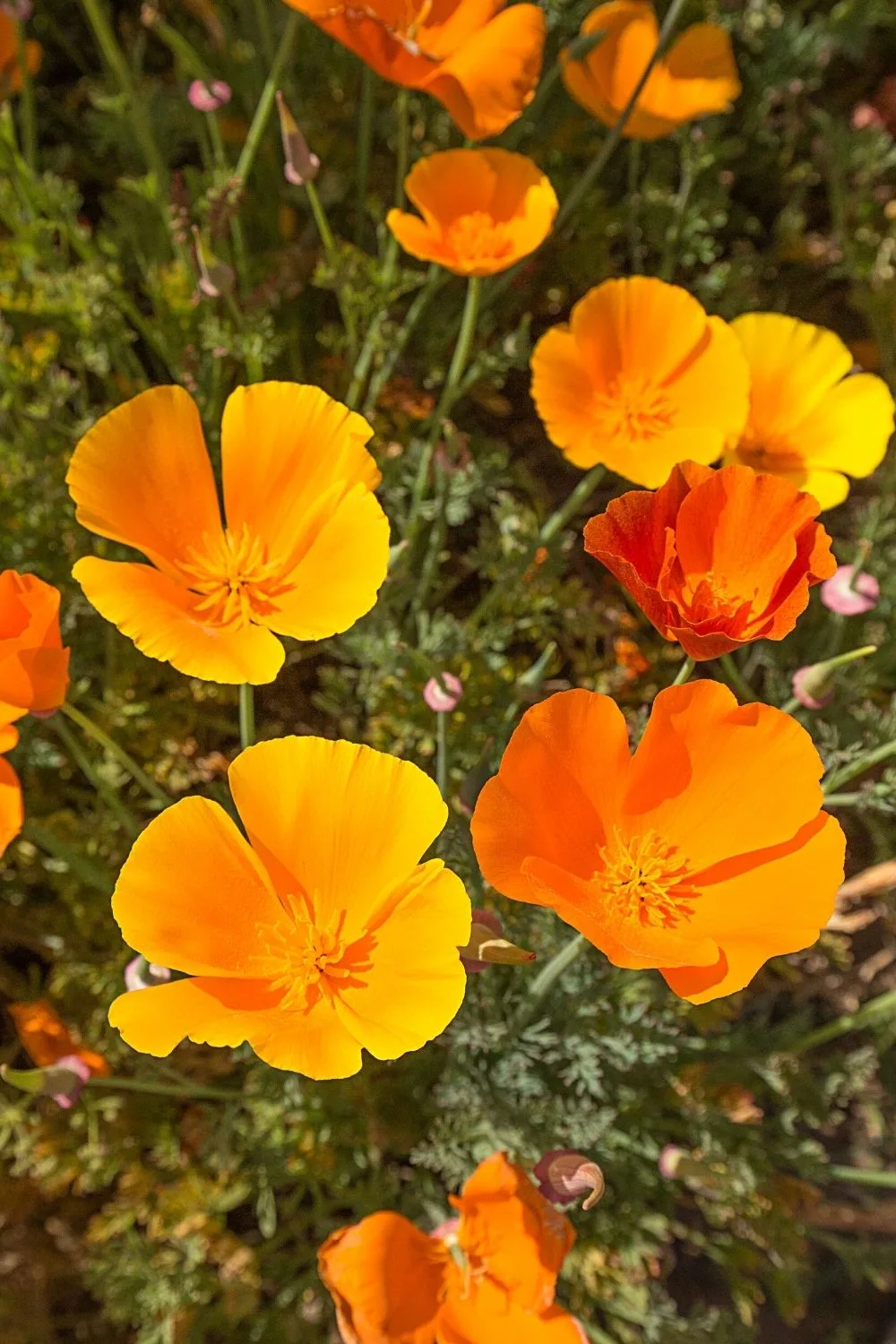
Another attractive plant that grows colorful blooms on your southwest facing garden is the California Poppy
This all-time favorite, California’s national flower, will bloom in colors of red, yellow, white, peach, and pinkish throughout the summertime.
The neatly trimmed blue-gray leaves also present a lovely sight.
- Name: Eschscholzia californica
- Size: 5 feet (18 inches) tall
- Zones: Annual
- Growth rate: Fast growers
- Temperature: 55-70 degrees Fahrenheit (12-21 degrees Celsius)
- Lighting: Blooms best in full sun
- Humidity: Low to moderate
- Soil: Sandy rocky soil is preferred
- pH: 5 to 7.5
12. Pineleaf Penstemon
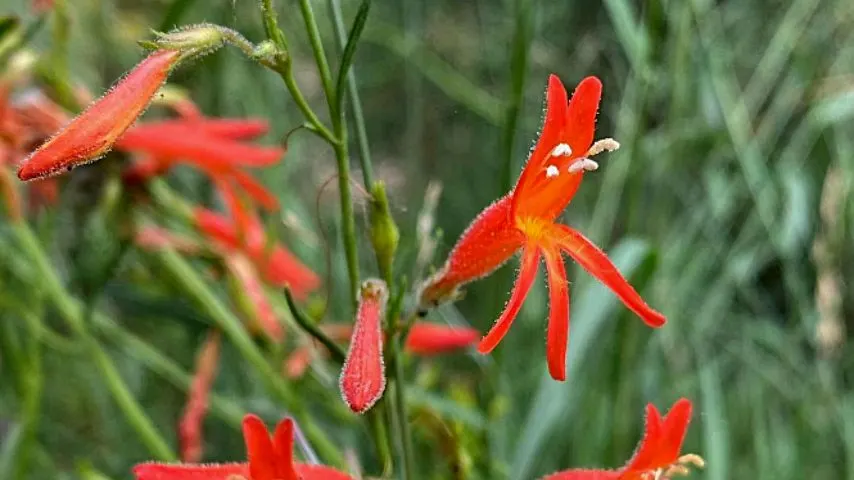
Photo Credit: @maxwellschultz on Instagram!
Pineleaf penstemon is an excellent perennial for enticing hummingbirds, with fine-textured leaves and vivid orange-red blooms that flourish for six weeks in the summertime.
- Name: Penstemon pinifolius
- Size: 3 feet (16 inches) tall
- Zones: Hardy in zones 4 to 9
- Fertilizer: Light application of organic fertilizer
- Growth rate: Moderately low
- Temperature: 0 to 100 degrees Fahrenheit (-17 to 37 degrees Celsius)
- Lighting: Full sun
- Soil: Wet clayey soil
- pH: Acidic, Alkaline, or Neutral
13. Wine Cups
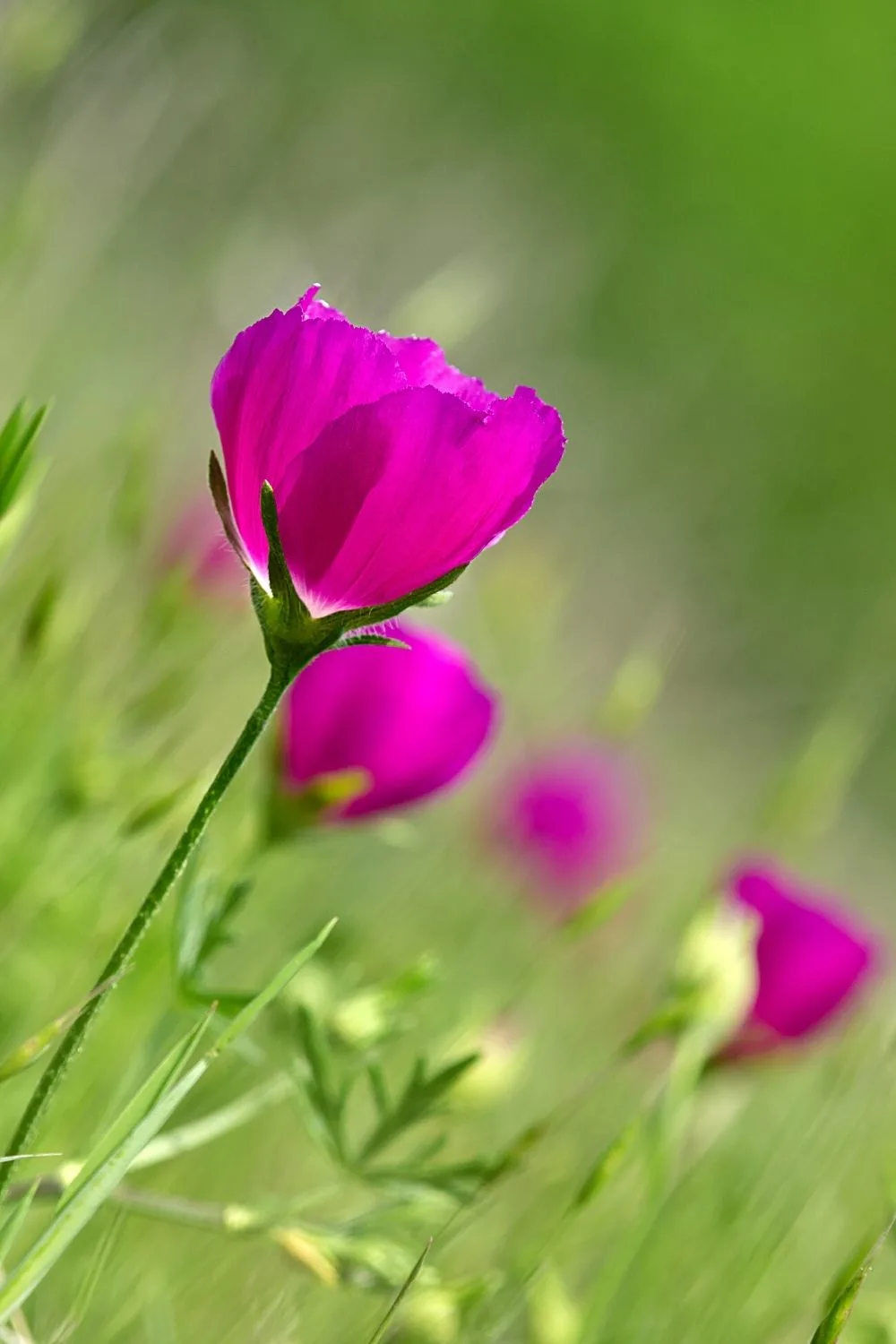
Wine Cups is your best choice of attractive groundcover for your southwest facing garden
Wine cups is a sturdy small groundcover with burgundy-red blooms that emerge in mid springtime to midsummer.
People adore its low-growing, elegantly split leaves even when it isn’t blooming.
- Name: Callirhoe involucrata
- Size: 1 foot (12 inches) tall
- Zones: Hardy in zones 4 to 8
- Growth rate:
- Temperature: 50-80 degrees Fahrenheit (10-26 degrees Celsius)
- Lighting: Full sun
- Humidity: High humidity
- Soil: Loamy, sandy, or rocky soil
- pH: 6 to 6.5
14. Yellow Columbine

Yellow Columbine is a heat-resistant plant that can thrive in a southwest-facing garden
Yellow columbine is one of the most attractive Desert Southwest species. It is quite strong and heat-tolerant.
Birds and insects love the yellow blooms, which continuously grow if deadheaded regularly.
- Name: Aquilegia chrysantha
- Size: Maximum of 3 feet (36 inches) tall
- Zones: Hardy in zones 4 to 8
- Fertilizer: Compost or well-rotted manure
- Growth rate: Medium
- Lighting: Full sun exposure
- Soil: Moist but well-drained loamy or sandy soil
- pH: 6 to 8
15. Indian Paintbrush
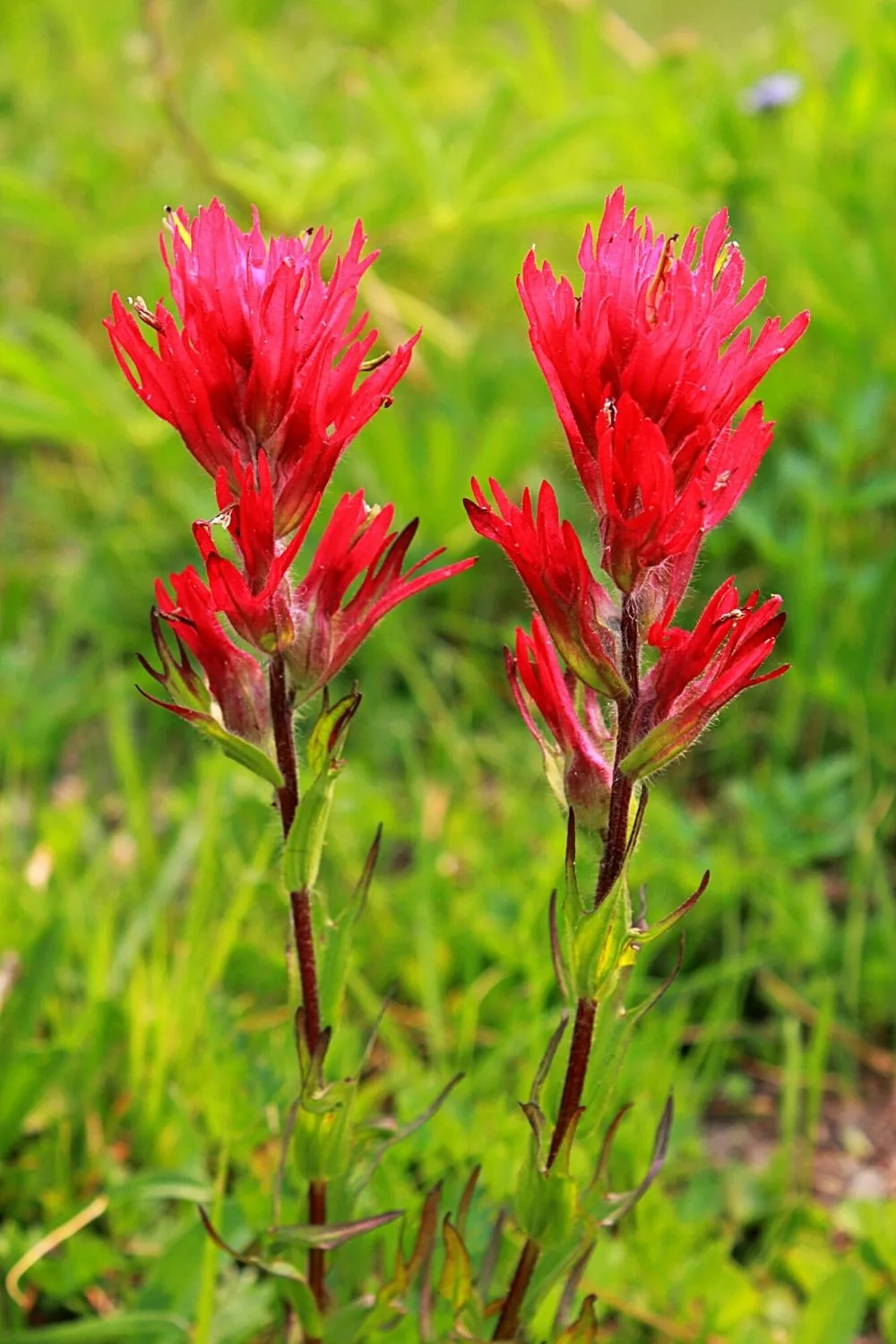
Indian Paintbrush is another drought-resistant plant that attracts butterflies to your southwest facing garden
This lovely, drought-tolerant plant will attract butterflies to your yard. From springtime through winter, beautiful vermillion-red blooms develop. This long-blooming perennial is a delight everywhere.
- Name: Castilleja integra
- Size: Maximum of 3 feet (36 inches) in height
- Zones: Hardy in zones 4 to 7
- Temperature: 57-65 degrees Fahrenheit (14-18 degrees Celsius)
- Lighting: Requires full sun
- Humidity: Moderate levels
- Soil: Well-draining
- pH: 6 to 7.1
16. Dill
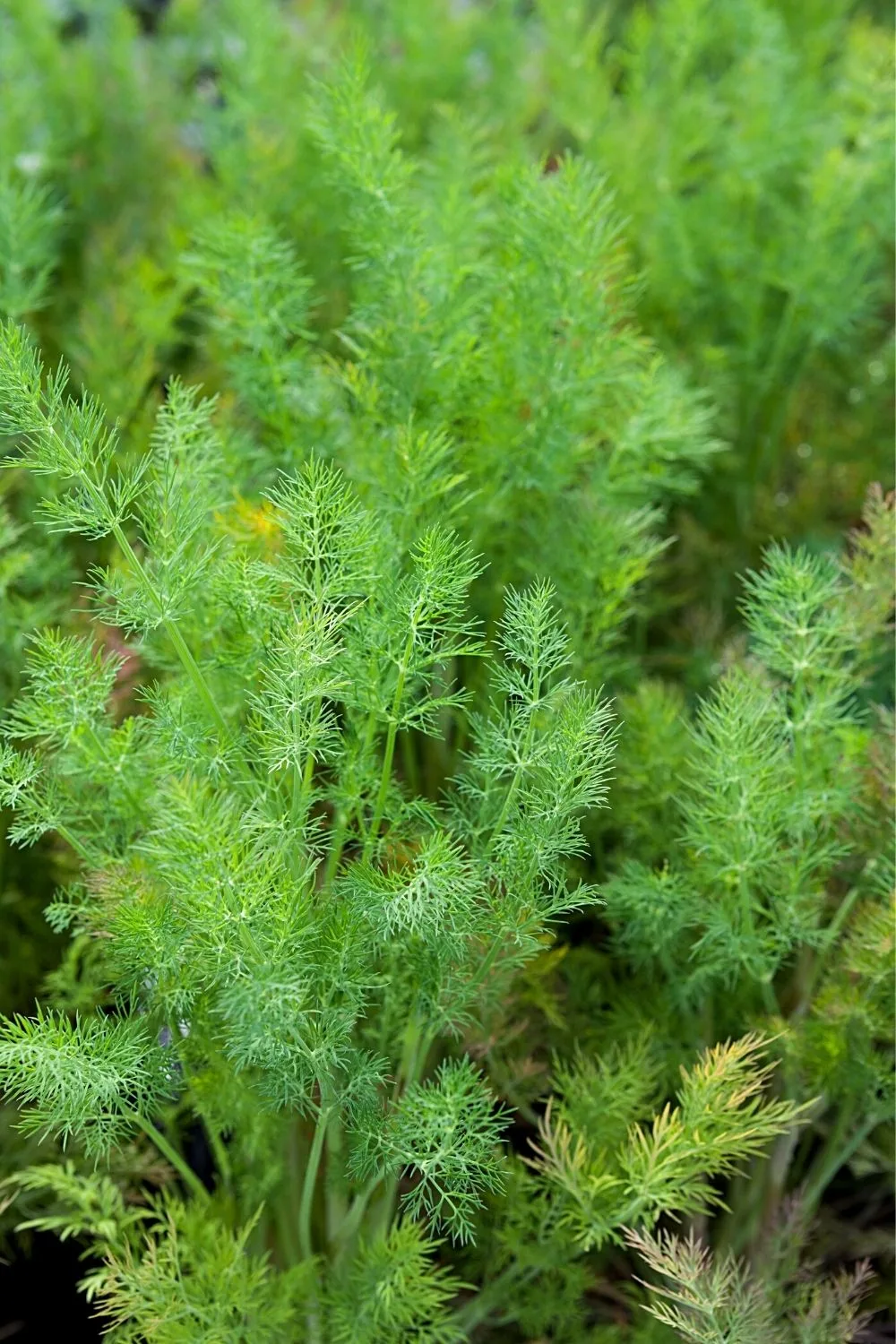
Dill is a great herb to add to your already colorful southwest facing garden
Dill is a food herb with a flavor combination of celery and fennel. It is indigenous to Asia and Europe, commonly used to flavor pickle food that is preserved and kept for the winter.
Aside from that, the Dill’s leaves are used to add flavor to a wide range of meals.
Dill’s fluffy foliage is beautiful, making it a good choice for flower gardens where it will draw insects and birds.
- Name: Anethum graveolens
- Size: 2 to 4 feet (24-48 inches) tall
- Zones: Hardy in zones 2 to 11
- Fertilizer: Rich in organic matter
- Growth rate: Slow grower
- Temperature: 70 degrees Fahrenheit (21 degrees Celsius)
- Lighting: 5 to 6 hours under direct sunlight
- Soil: Loamy or sandy, well-drained
- pH: 8 to 6.5
17. Sedums
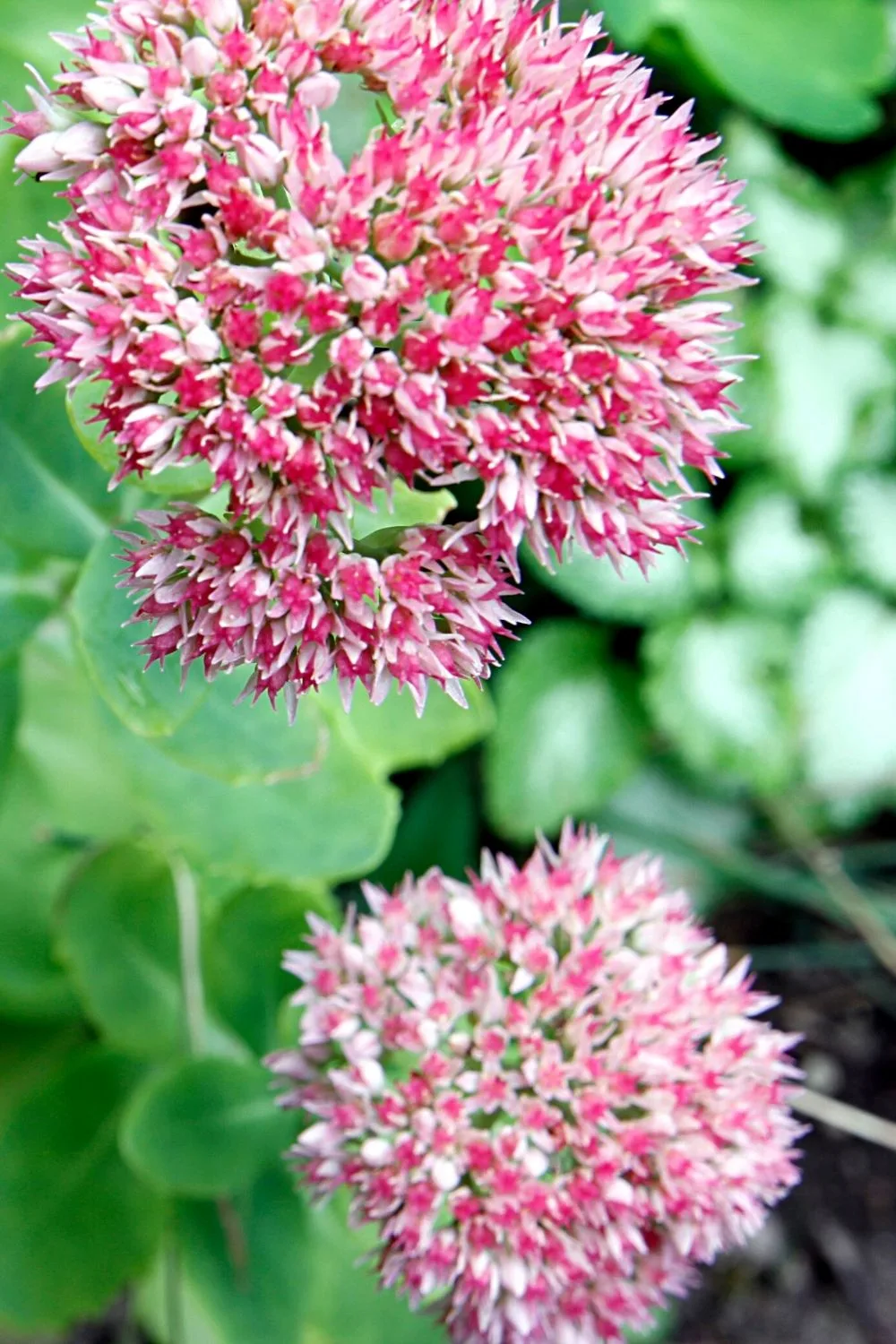
Sedums come in various shapes and designs that thrive best in a southwest facing garden
Sedum is a perennial flower with fleshy foliage, thick branches, and star-shaped flower bunches.
It is often referred to as stonecrop and comes in various shapes and species, making it suitable for use in any garden design. They’re sturdy, easy to take care of, and pollinators love them.
- Name: Stonecrop
- Size: Can grow up to 0.5 to 2 feet (6-24 inches) tall
- Zones: Hardy in Zones 4 to 9
- Fertilizer: All-purpose granular fertilizer having equal parts of NPK
- Growth rate: Moderate growth rate
- Temperature: 60-70 degrees Fahrenheit (15-21 degrees Celsius)
- Lighting: Does best in the full sun
- Humidity: Tolerates humidity well
- Soil: Well-draining, loamy and sandy soil
- pH: Overall optimal pH of 5.95
18. Lisianthus
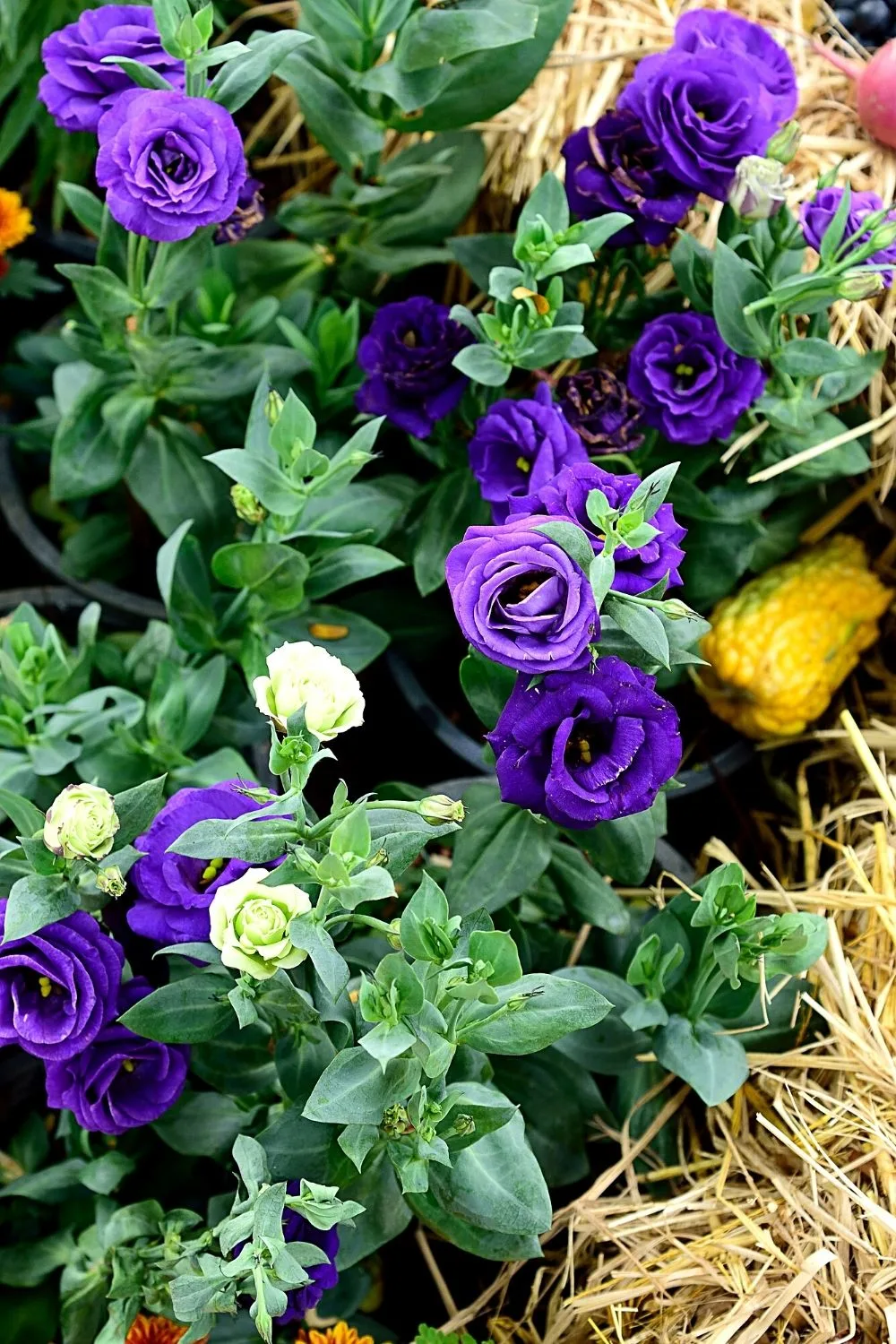
Lisianthus is a stylish and flexible flower that you can grow in your southwest facing garden
Lisianthus is the definition of a stylish, flexible flower and is typically selected by a florist when a beautiful inflorescence is desired for a design.
The curled petals and graceful buds are available in various colors.
The delicate-looking blossoms are prized for their attractiveness and capacity to last two weeks in a jar after being plucked.
- Name: Eustoma
- Size: 1 to 3 feet (12-36 inches) tall
- Zones: Hardy in zones 8 to 10
- Fertilizer: Flower fertilizer of 1 ½ time the amount of potassium as nitrogen
- Growth rate: Slow grower
- Temperature: 65-70 degrees Fahrenheit (18-21 degrees Celsius)
- Lighting: A spot where there is full sun
- Humidity: Does not tolerate high humidity
- Soil: Well-draining moist soil
- pH: 5 to 7
19. Gold Mound Spirea
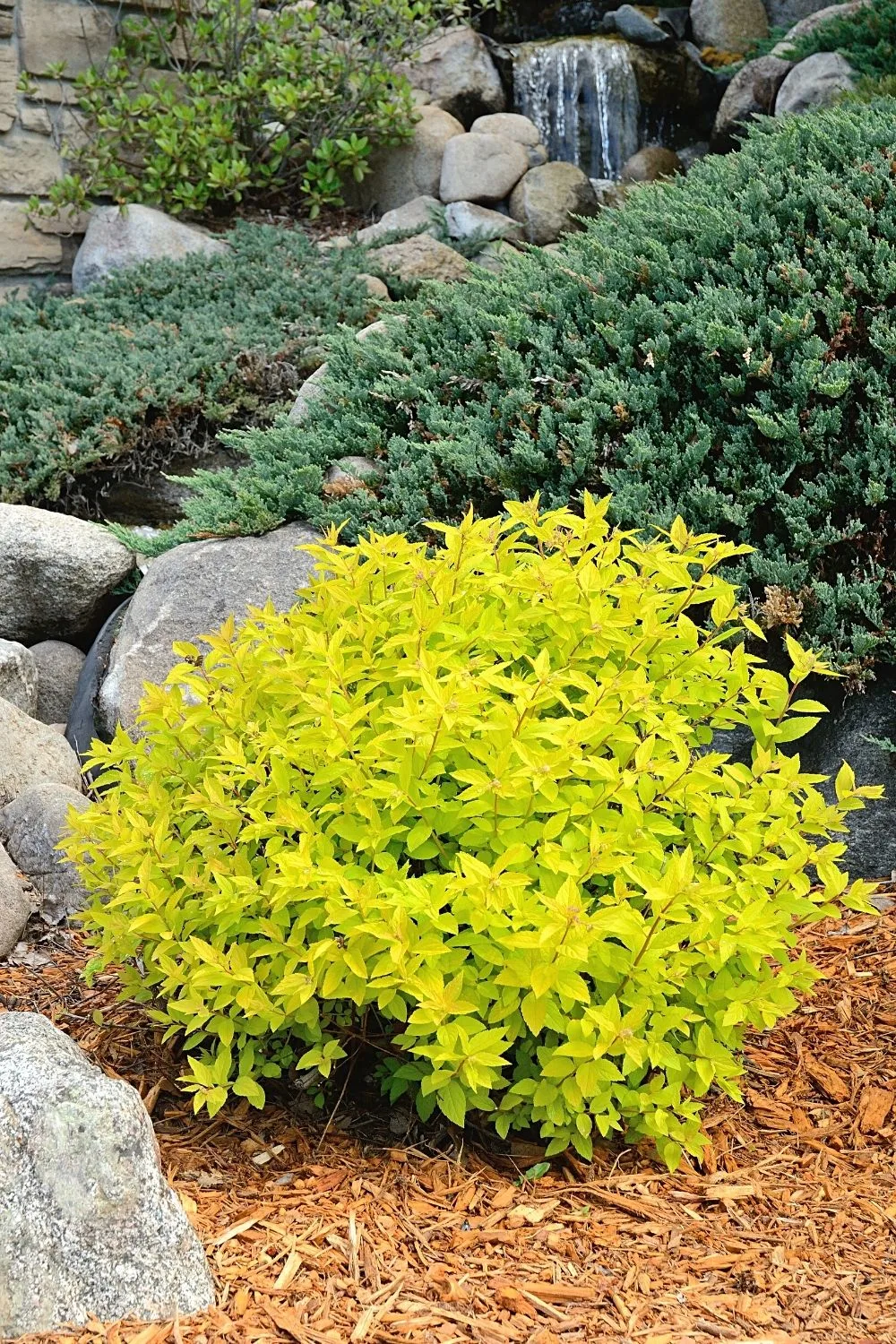
Known for its golden leaves in the springtime and vivid yellow during autumn, Gold Mound Spirea adds another color splash to your southwest facing garden
The Gold Mound spirea is a perennial shrub with dazzling golden leaves in springtime and vivid yellow in the autumn.
Many shrubs may have more attractive blooms or fall leaves, but this one shines in the spring. It gets its name from its gold leaves and mound-like behavior it has.
- Name: Spiraea Japonica ‘Goldmound’
- Size: 2 to 3 feet (24-36 inches) tall
- Zones: Hardy in zones 4 to 8
- Fertilizer: A general-purpose garden fertilizer
- Growth rate: Fast grower
- Temperature: Tolerant to high temperatures
- Lighting: Full sun exposure
- Humidity: Will work fine in high humidity
- Soil: Well-draining and loamy
- pH: 5 to 7.5
20. Basil

An aromatic, warm-weather herb, Basil will thrive when planted on a southwest facing garden
Basil is an aromatic, warm-weather plant that goes well in a variety of meals, such as the renowned fresh pesto.
Sow seeds or transplant once the cold season has ended, the ground is warm, and you’ll have a plentiful crop in a few weeks.
Continue to prune the basil’s foliage to hold the plant alive and well.
- Name: Ocimum Basilicum
- Size: 1 to 2 feet (12-24 inches) tall
- Zones: Hardy in zones 11 to 12
- Fertilizer: Use organic fertilizer once in 2-3 weeks
- Growth rate: Grows very quickly
- Temperature: 50 to 80 degrees Fahrenheit (10-26 degrees Celsius)
- Lighting: 6 to 8 hours of direct sun exposure
- Humidity: 60 to 65 percentage
- Soil: Moist, well-draining, and rich
- pH: 6 to 7
21. Begonias
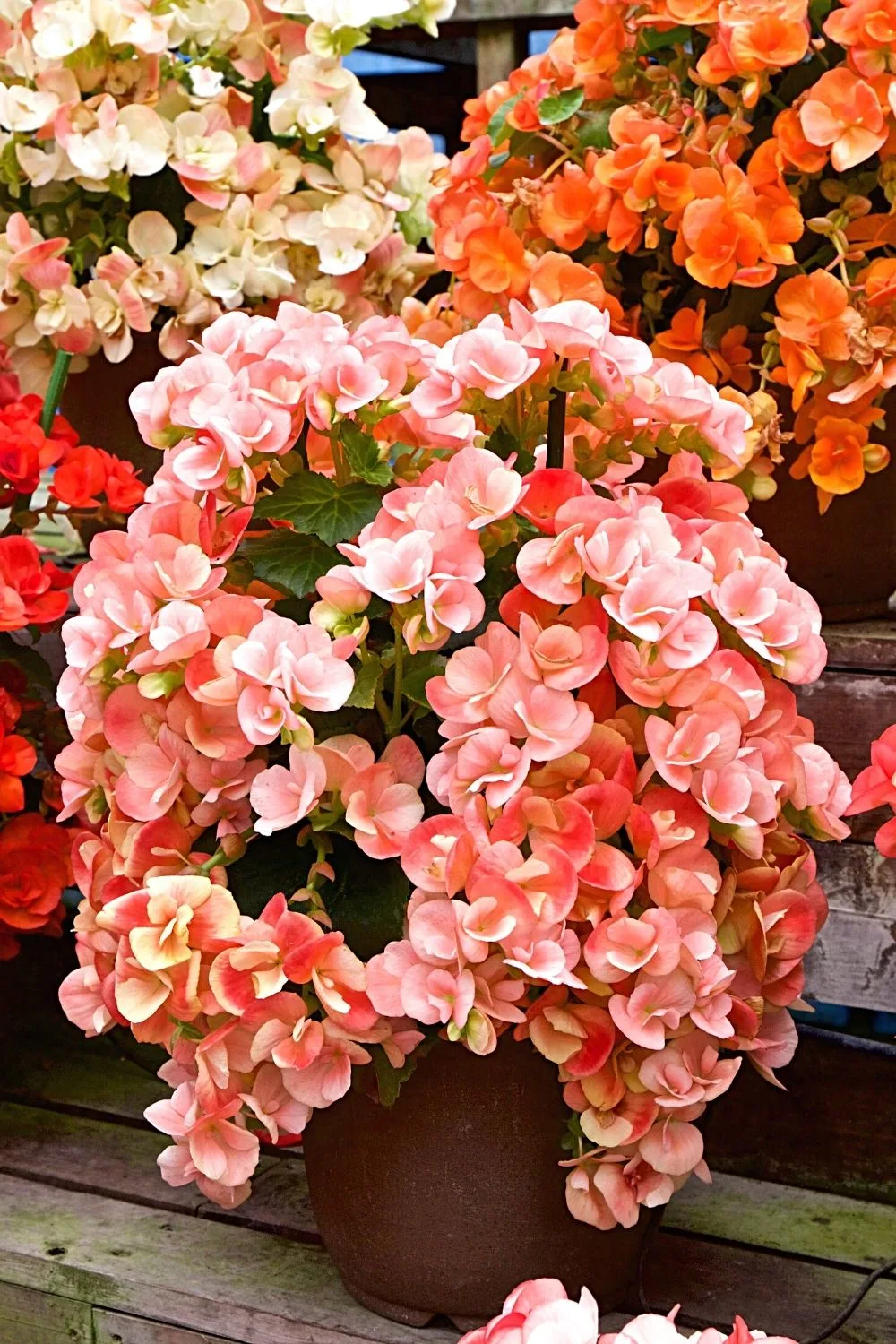
Begonias’ colorful blooms add another splash of color on your southwest facing garden
Begonias are tropical and subtropical plants commonly grown as houseplants and in shady summer beds.
Some are planted for their asymmetric, irregular, and varied foliage, while others are cultivated for their colorful blossoms, which provide color to shady garden regions.
Begonia plants provide a great punch of color and appeal despite their modest size.
- Name: Begonia
- Size: 5 feet (60 inches) tall
- Zones: Hardy in zone 8 to 10
- Fertilizer: A balanced liquid fertilizer (10-10-10)
- Growth rate: Fast growers
- Temperature: 65-72 degrees Fahrenheit (18-21 degrees Celsius)
- Lighting: Full sun exposure during the day
- Humidity: 50 percentage
- Soil: Fertile, light, and well-draining
- pH: 2 to 6
22. Rosemary

Rosemary is another aromatic herb you can grow in your southwest facing garden
Rosemary may be planted as a garden decorative and is famous for its great aroma and flavor. These herbs can be cultivated annually in locations where there is warmth.
These herbs flourish in hot, dry climates due to their Mediterranean background. Plant rosemary along paths and sidewalks to unleash its scent as you pass by.
- Name: Salvia Rosmarinus
- Size: 1 to 3 feet (12-36 inches) tall
- Zones: Hardy in zones 8 to 10
- Fertilizer: Non-acidic, organic liquid fertilizer
- Growth rate: Slow grower initially but will be fast in the second year
- Temperature: 55-80 degrees Fahrenheit (12-26 degrees Celsius)
- Lighting: 6 hours of direct full sun
- Humidity: 45 to 55 percent
- Soil: Loamy and well-draining
- pH: 6 to 7.5
23. Dwarf Fothergilla (Fothergilla Mount Airy)
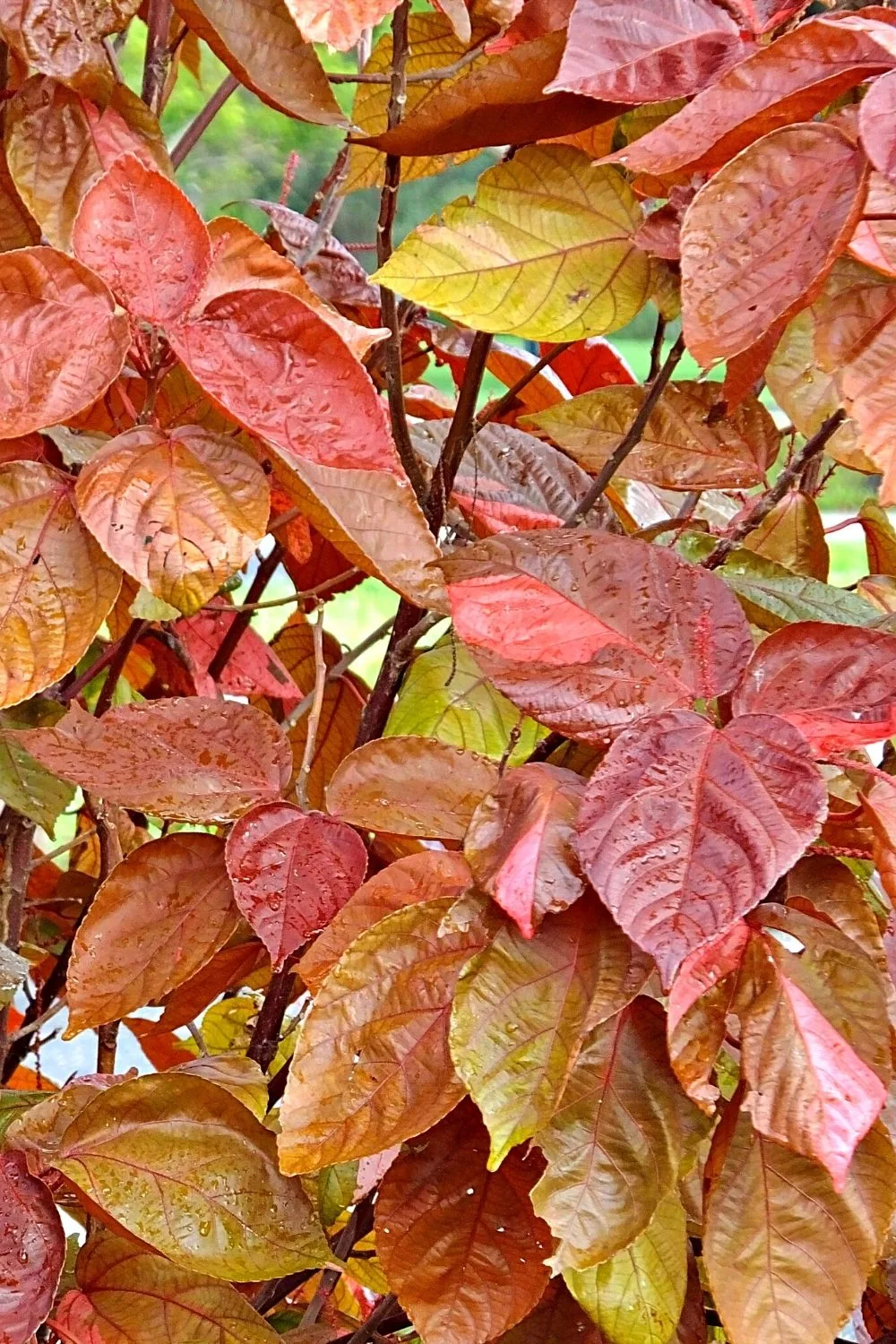
Dwarf Fothergilla (Fothergilla Mount Airy), a famous plant for landscaping, grows best in southwest facing gardens
Due to its numerous blossoms in the springtime, lush leaves in the summers, and brilliant colors of red, orange, and lavender in the autumn, Fothergilla is a very valued plant in landscaping.
- Name: Fothergilla Gardenii
- Size: 2 to 3 feet (24-36 inches) tall
- Zones: Hardy in zones 5 to 8
- Fertilizer: Slow-release, balanced granular fertilizer
- Growth rate: Slow grower
- Lighting: Partial shade to full sun
- Soil: Well-draining with medium moisture and slightly acidic
- pH: 5 to 6
24. Chives
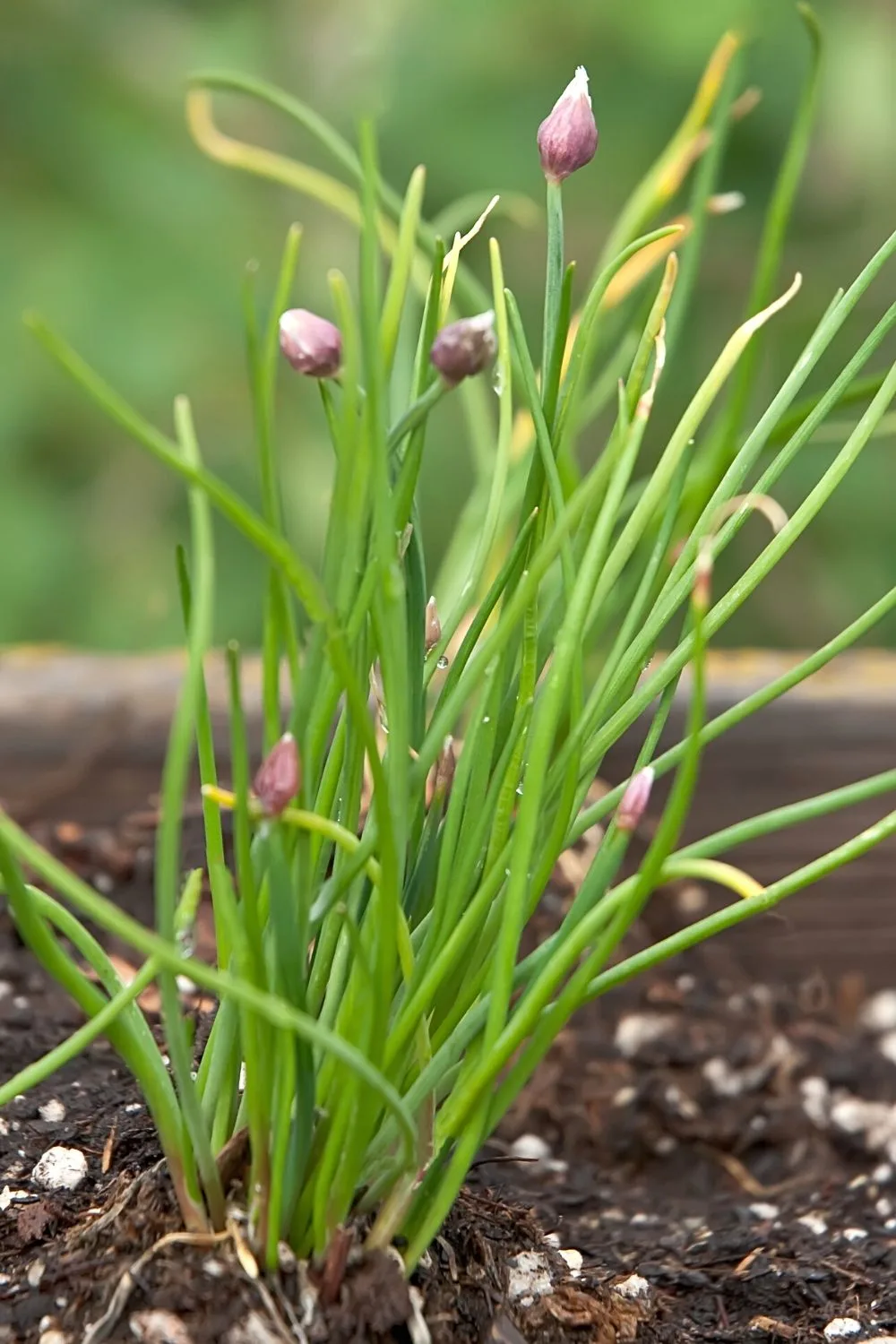
Chives, a member of the onion family, is another great addition to your southwest facing garden
Allium schoenoprasum, the chive plant, is a part of the onion family. This attractive garden annual has lavender blooms, a clump-forming behavior, and is winter hardy.
Its flat, grass-like blades have a faint onion flavor and are commonly used in salad and sauces. In mid-May or June, the little plumes of blooms start to emerge that can be eaten.
- Name: Allium Schoenoprasum
- Size: 1 foot (12 inches) tall
- Zones: Hardy in zones 3 to 10
- Fertilizer: Light general-purpose fertilizer in spring
- Growth rate: Slow-growing
- Temperature: 40 to 85 degrees Fahrenheit (4-29 degrees Celsius)
- Lighting: 6-8 hours under full, direct sunlight
- Humidity: 40 percent
- Soil: Well-draining and rich in organic matter
- pH: 6 to 7
25. Pentas
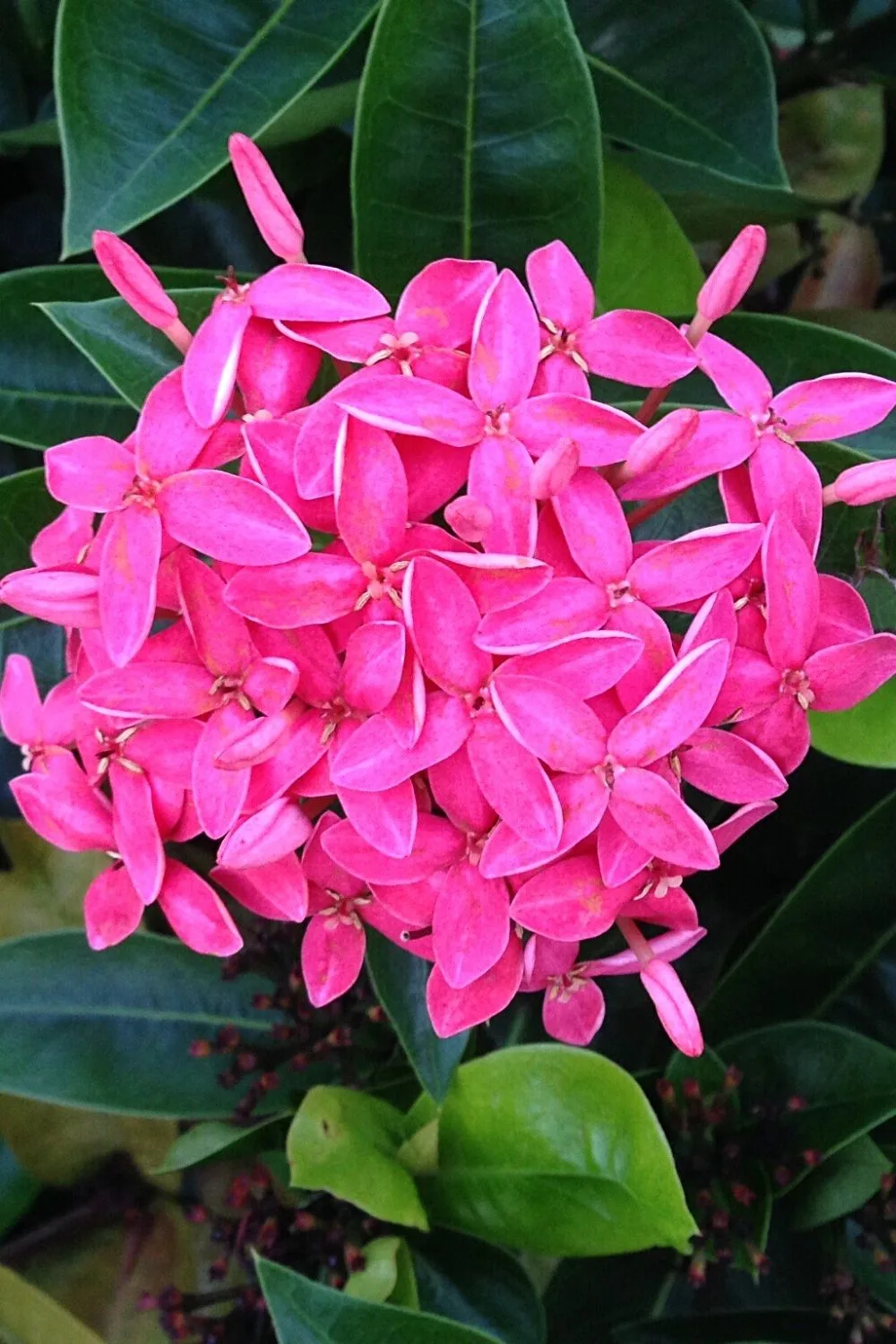
Pentas, aka Egyptian stars, will easily beautify your southwest facing garden
Because of the five-pointed design of the bloom, Pentas are also known as Egyptian stars. It’s a scraggly shrub with irregularly formed leaves that ranges from round to pear-shaped.
Blooms are typically red, white, or pink, but recent varieties have added lavender and purple hues and combination flowers like pink with red centers.
- Name: Pentas
- Size: 2 to 3 feet (24-36 inches) tall
- Zones: Hardy in zones 9 to 11
- Fertilizer: Granular slow-release fertilizer
- Growth rate: Slow grower
- Temperature: 65-75 degrees Fahrenheit (18-24 degrees Celsius)
- Lighting: Grows abundantly in full sun
- Humidity: 95 to 98 percent
- Soil: Slightly acidic and well-draining
- pH: 6
26. Rock Cotoneaster

Rock Cotoneaster (Cotoneaster Horizontalis) is a very simple plant to grow on your southwest facing garden
Rock cotoneaster is a simple plant to cultivate since, once rooted; it can thrive and develop by itself, as long as it is not subjected to extended drought.
Grown cotoneaster is one of the most tenacious plants in the landscape, flourishing even when ignored.
On the other hand, freshly planted cotoneaster plants require a little extra attention; make sure they get enough watering as they grow.
- Name: Cotoneaster Horizontalis
- Size: 2 to 3 feet (24-36 inches) tall
- Zones: Hardy in zones 5 to 7
- Fertilizer: Slow-release granular fertilizer
- Growth rate: Slow-growing shrub
- Lighting: Full sun
- Humidity: Relatively low humidity is tolerated
- Soil: Loamy and well-draining
- pH: 75 to 7.5
27. Tatarian Dogwood
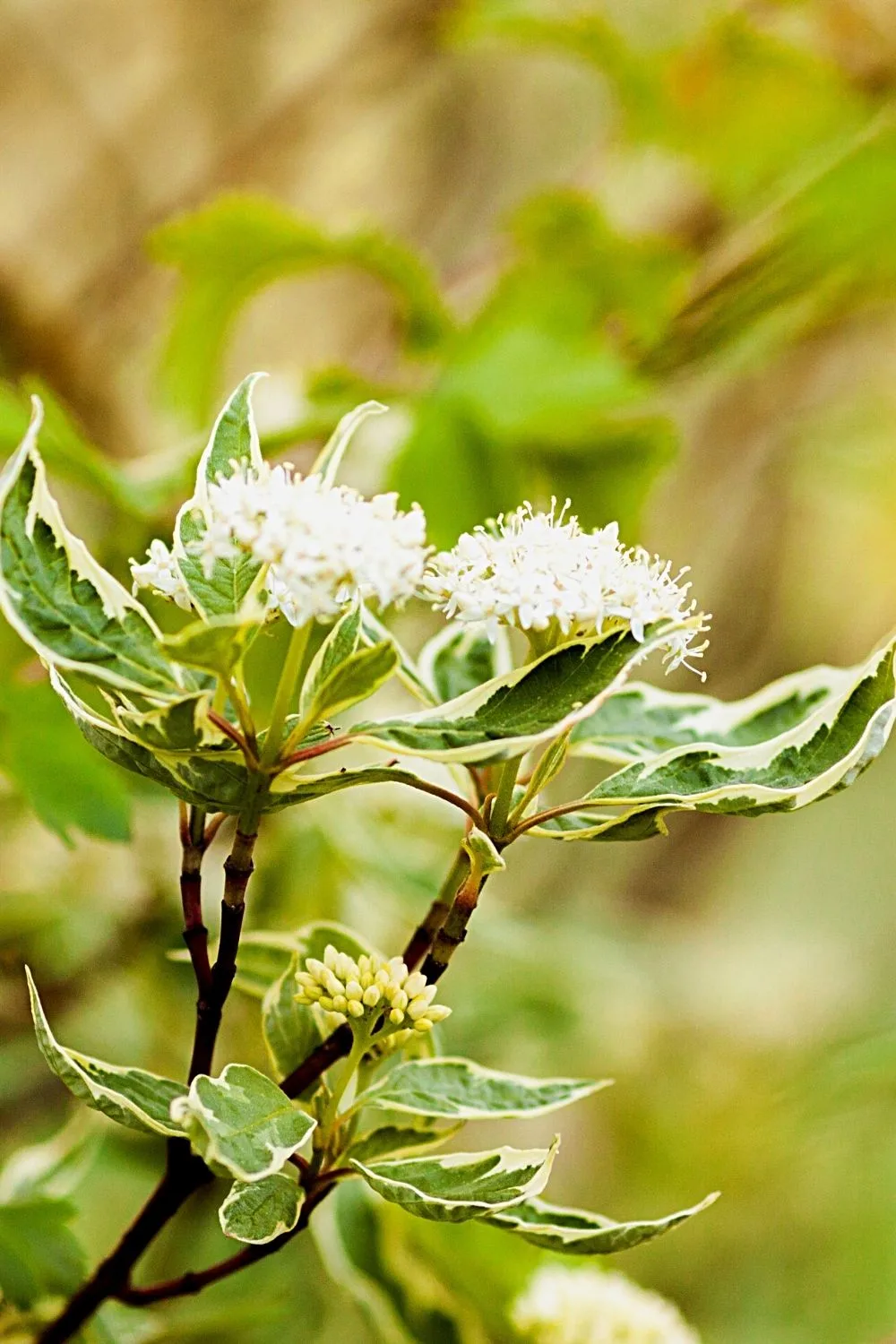
Tatarian Dogwood (Cornas Alba) is known to add appeal to your southwest facing garden during winter
Tatarian dogwood is a Cornaceae family plant. It’s cultivated for its winter appeal and decorative potential.
It can be trimmed into a tiny tree if desired. It develops an erect and loose shape with tall unbranched stems as it matures.
Because it tends to create enormous colonies, keep in mind that root trimming may be required.
- Name: Cornus Alba
- Size: 6 to 0.8 feet (8-10 inches) tall
- Zones: Hardy in zones 3 to 7
- Fertilizer: Once every 2-3 weeks using balanced fertilizer
- Growth rate: Fast grower
- Lighting: Sunny and partial shade
- Soil: Medium, deep and fertile with organic matter
- pH: 5 to 7
28. Thyme
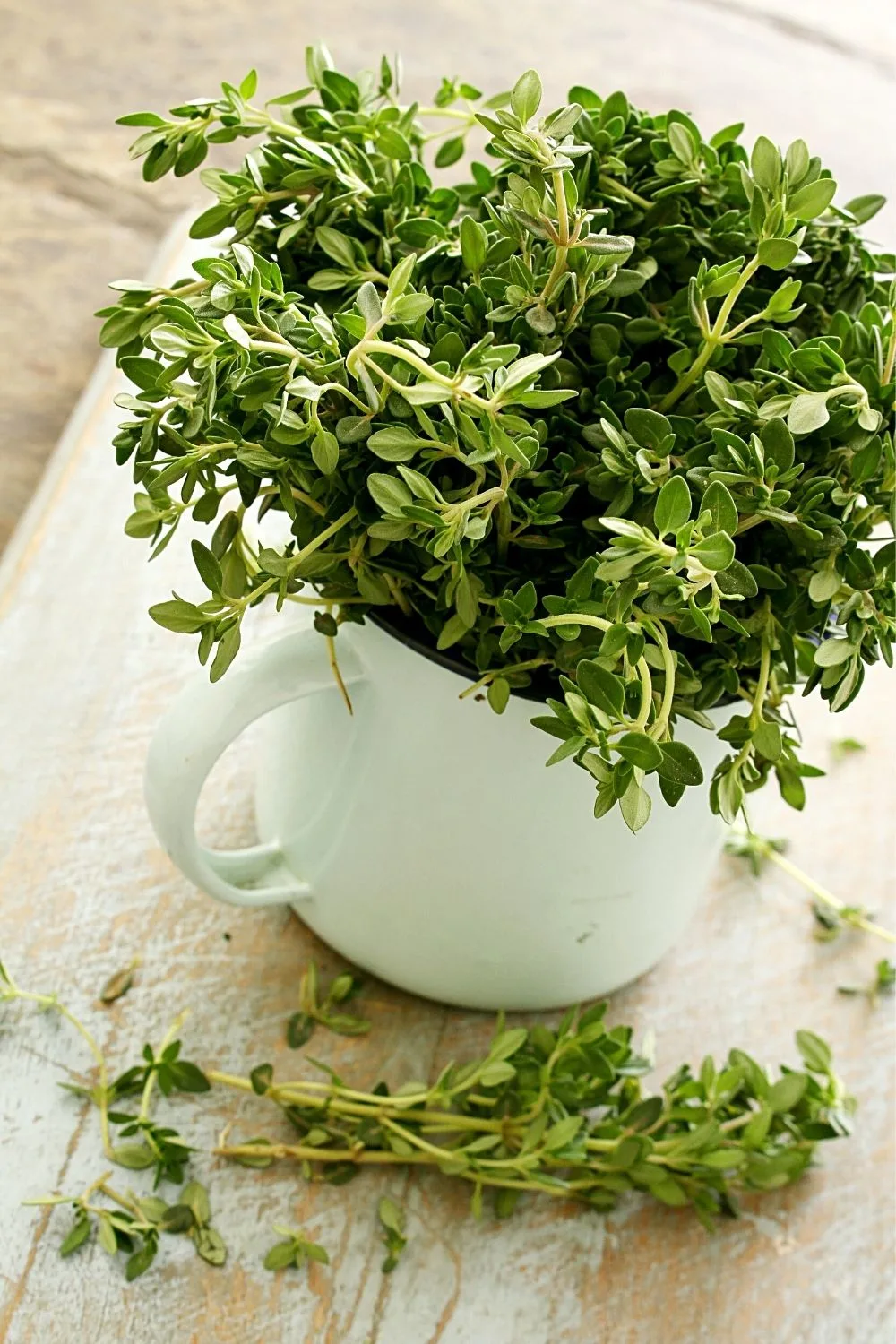
Thyme grows a clover flower that is both sweet and spicy that is a great addition to your southwest facing garden
Thyme is a lovely plant with a sweet-and-spicy clover flavor that smells like summer to us!
There are beautiful decorative thyme cultivars as well as culinary thyme that provide a savory accent to stews, grilled chicken, and vegetables throughout the summertime.
It is an aromatic herb with tiny, scented leaflets and slender, woody stalks that grows as a low-growing resistant perennial.
- Name: Thymus Vulgaris
- Size: 5 to 1 foot (6-12 inches) tall
- Zones: Hardy in zones 5 to 9
- Fertilizer: Every two weeks, a mild mixture of fish emulsion or liquefied seaweed, reduced by half
- Growth rate: Slow grower from seed
- Temperature: 21-28 degrees Celsius (69-84 degrees Fahrenheit)
- Lighting: 10 hours of direct bright sun
- Humidity: 40 percent
- Soil: Well-draining loamy or sandy
- pH: 6 to 7
29. Sweet Alyssum
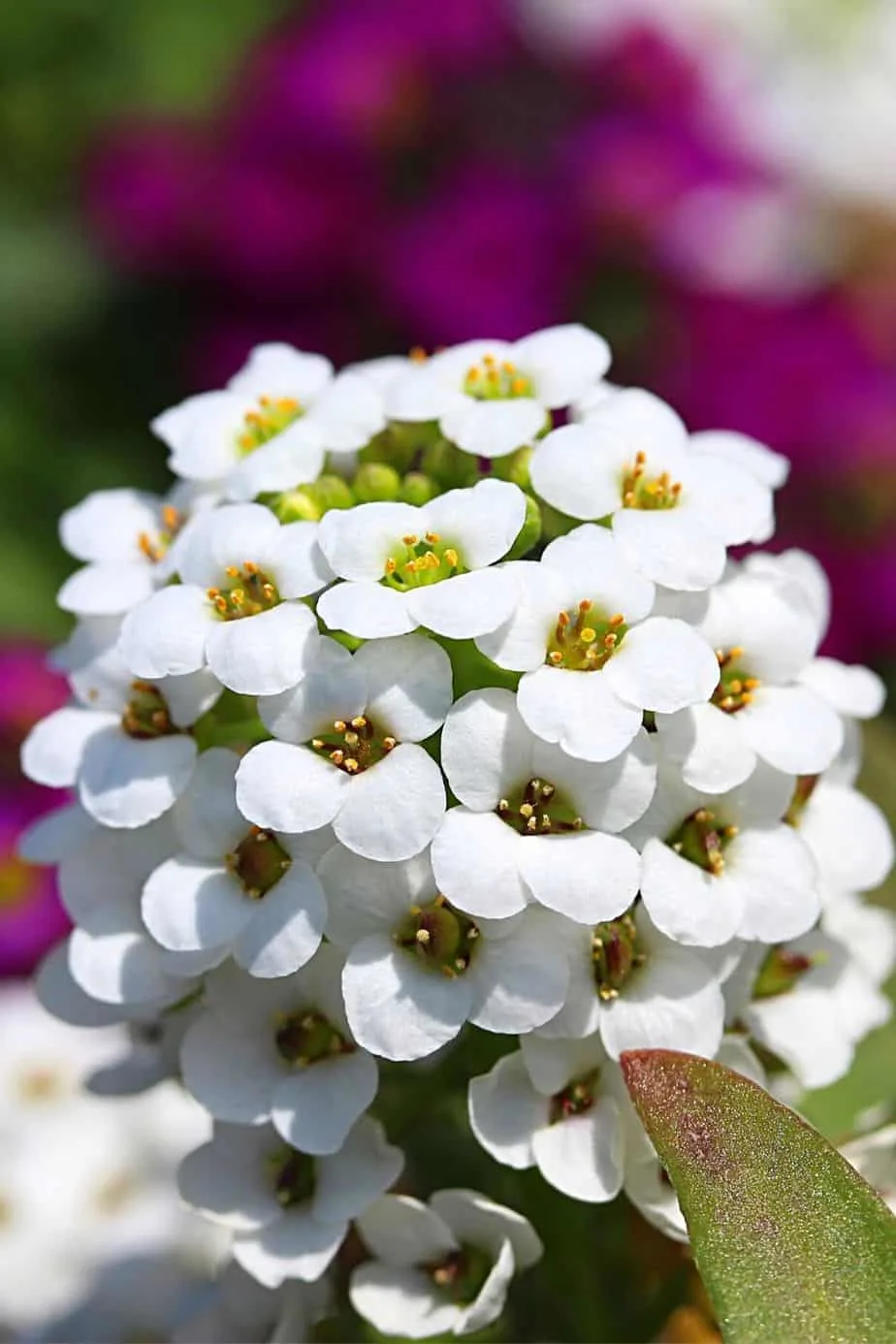
Sweet Alyssum is a great-smelling plant to grow on your southwest facing garden
Sweet alyssum flowers are part of the mustard genus and are renowned for their vibrant smell. Sweet alyssum flowers can self-sow and give you season after vibrant season color in milder regions.
Alpine rocky landscapes, hedges, containers, swinging baskets, and arid zones benefit from sweet alyssum flowers.
- Name: Lobularia Maritima
- Size: 25 to 0.75 feet (3-9 inches) tall
- Zones: Hardy in zones 5 to 9
- Fertilizer: Well-balanced water-soluble fertilizer on a monthly basis
- Growth rate: Fast-growing plant
- Temperature: 65-70 degrees Fahrenheit (18-21 degrees Celsius)
- Lighting: 6 hours of full sun
- Soil: Will tolerate moist soil but should drain well
- pH: 6 to 7
30. Flamingo Willow
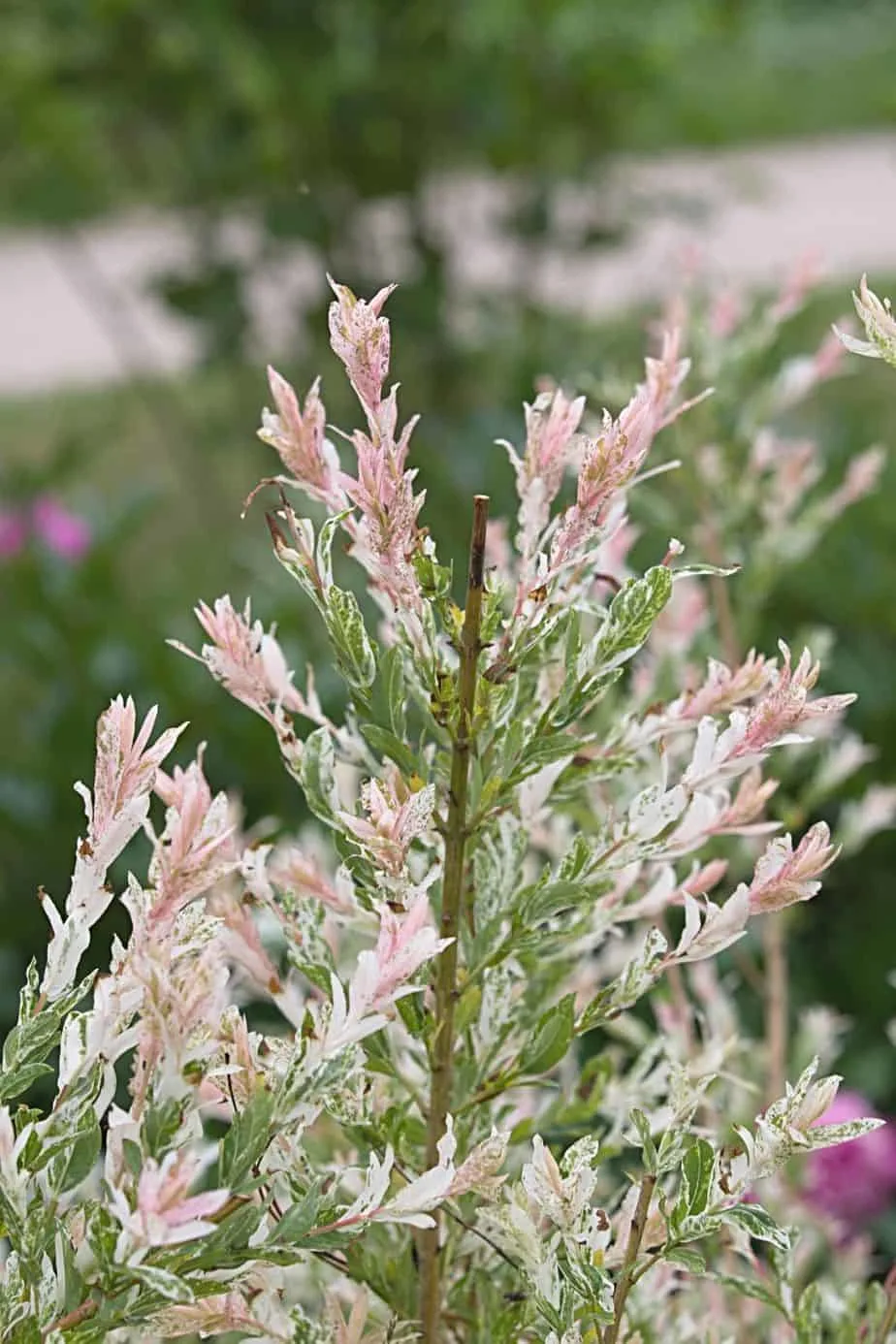
Flamingo Willow (Salix Integra Flamingo) is another colorful plant to grow on your southwest facing garden
The flamingo tree is a beautiful miniature willow with flamingo-pink ends and a mosaic combination of green and white leaves in the springtime.
In the summers, the foliage change color, and as they fall in autumn, the coral-orange branches are visible.
Yellow seed pods develop before the leaves return in the springtime. It could be used as a stand-alone specimen, in small clusters, or even on a fence border.
- Name: Salix Integra Flamingo
- Size: 4 to 6 feet (48-72 inches) tall
- Zones: Hardy in zones 5 to 7
- Fertilizer: Compost dug or general-purpose balanced fertilizer
- Growth rate: Fast-growing trees
- Temperature: Tolerates lowest temperature from -30 to -20 degrees Fahrenheit (-34 to -29 degrees Celsius)
- Lighting: Full sun for best color of leaves
- Soil: Well-draining moist soil
- pH:6 to 7.8

Daniel has been a plant enthusiast for over 20 years. He owns hundreds of houseplants and prepares for the chili growing seasons yearly with great anticipation. His favorite plants are plant species in the Araceae family, such as Monstera, Philodendron, and Anthurium. He also loves gardening and is growing hot peppers, tomatoes, and many more vegetables.

![30 Plants for Southwest Facing Garden — Best Guide [2024]](https://plantophiles.com/wp-content/uploads/2022/04/30-Plants-for-Southwest-Facing-Garden-720x405.jpg.webp)
